
Essential WHISTLER Perfect PATAGONIA Soulful SUN VALLEY Olé! Olé! + HIGH SEASON 22/23 WHEN YOUR NEIGHBOR HAS AN A-STAR - FLYING MOOSE REVELSTOKE The Hottest Fashion in the Ring
When science, innovation, technology and creativity collide with a common goal of creating something unlike anything else, you get Peak Skis by Bode Miller. Not just a new ski. A radically better ski. For every part of the mountain. But only available at PeakSkis.com

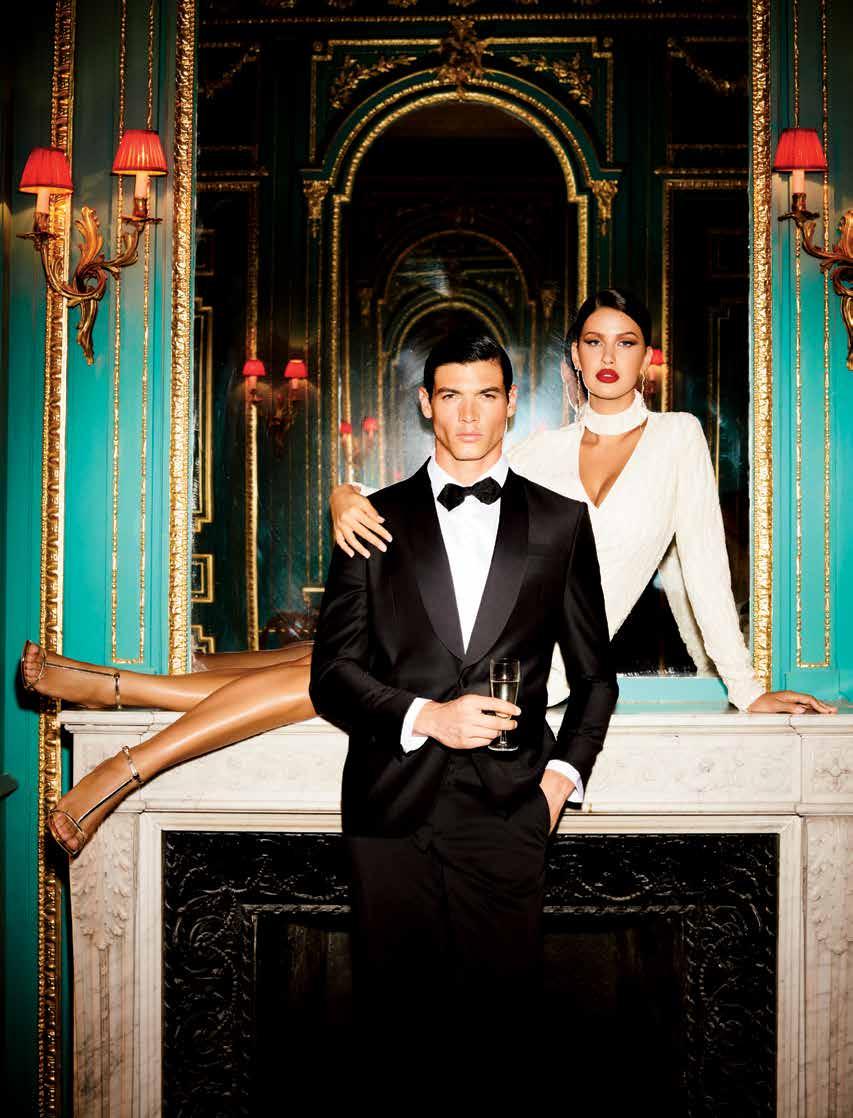





 GOLDBERGH.COM
welcome to the world of goldbergh
Welcome to the world of GOLDBERGH
GOLDBERGH.COM
welcome to the world of goldbergh
Welcome to the world of GOLDBERGH












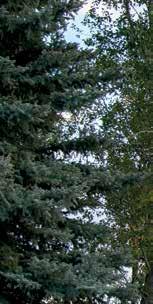



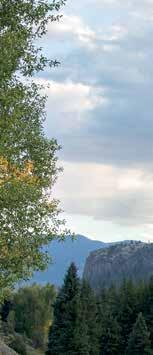



































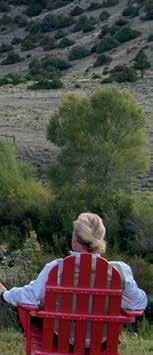













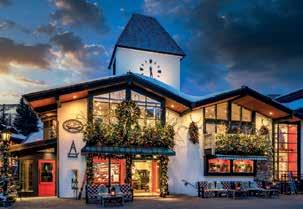









TONI SAILER COLE SPORT park city . deer valley 435.649.4800 . colesport.com
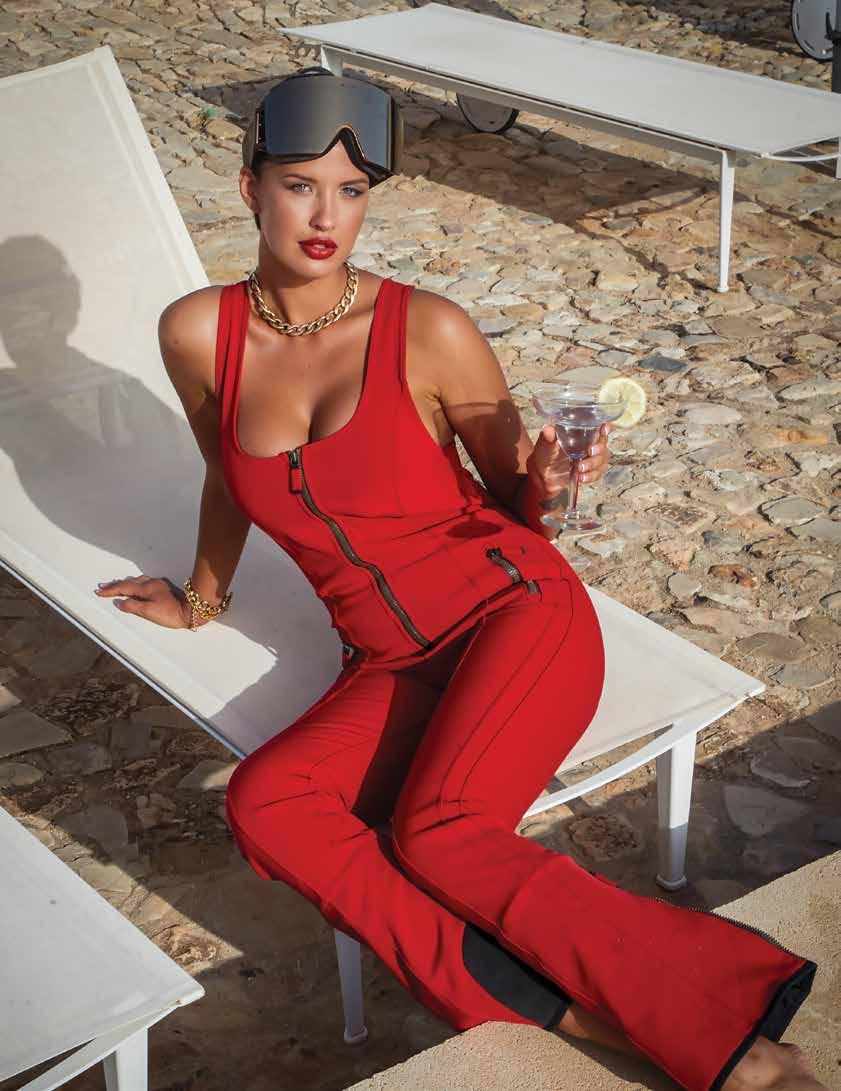


SNOWTEQUILA.COM




























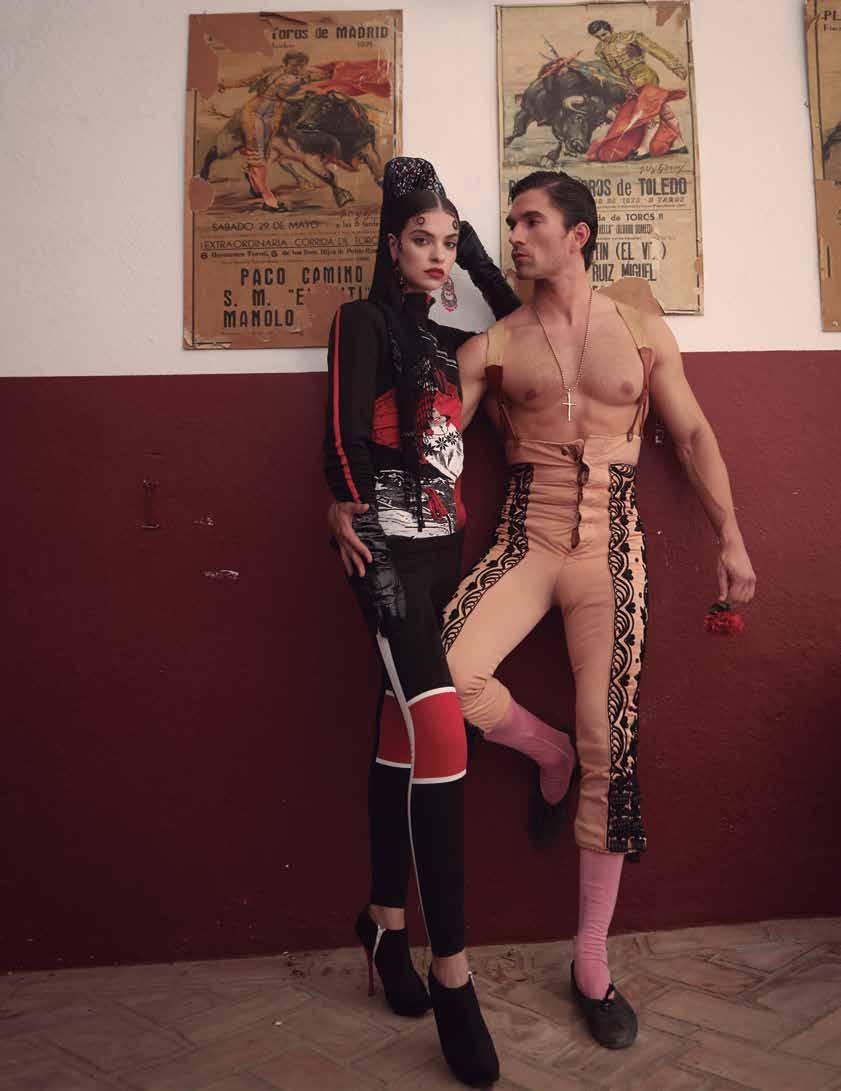

HIGH SEASON 22/23 ' THE COOLEST SKIWEAR AND APRÈS-SKI FASHION FOR 22-23, SHOT ON LOCATION IN STEAMY ANTEQUERA, SPAIN, THE CROSSROADS OF ANDALUSIA. TORO! TORO! 84 MEET FOUR FEMALE-OWNED-ANDOPERATED BRANDS THAT ARE CHANGING THE WAY WE THINK ABOUT SKI FASHION. THE FEMININE MYSTIQUE 108 LIVING LA VIDA BUENA, SKIING THE VOLCANOES IN CHILE’S PATAGONIA. HEART LAND 114 SIZE MATTERS IN CANADA’S WHISTLER BLACKCOMB. TOUCHING THE EDGE 96 this page BASELAYER NEWLAND FROM ITALY PANT NEWLAND FROM ITALY on the cover
MODEL
SKI SUIT
NECKLACE UNOS DE 50 WRAP IT-SPAIN ShotonlocationinSpain
CONTENTS
PHOTO BY ANTONIO CORDERO
LIZA MAKHU
FRAUENSCHUH

FLURRIES 29
From VIP gondola cars and lunching in Lech, to great reads, fine fondues, and more.
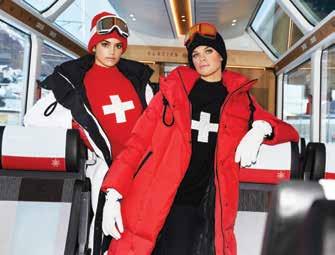

STYLE 38

It’s a wonderful, wicked whiteout on the slopes this season.
BEAUTY 40
These pocket-sized products make mountain-top beauty a snap.

TECH 44
Going deeper with a little Therabody TLC.
WELLNESS 48
Ski-B-D products to make every skier’s life calmer and better.

BOTTLE 52
Meet the world’s first alpine tequila. Snow Te-Ski-La is ready to make your après ski unforgettably delicious.
PERFECT PLACES 58
Sun Valley skiing is iconic and independent—but most importantly, the Valley’s got soul.
SUITES 66
Flying Moose Lodge is Revelstoke’s ritzy address, heli-pad included.

SPA 70
Switzerland's Hotel Cervo. brings a world approach to wellness
BOUTIQUE 74
If Vintage Ski World doesn’t have it in its storefront of ski memorabilia, you don’t need it.
HELI 78
For skiers heading to the Southern Hemisphere, Reggie Crist and Stellar Chile have something special indeed.

SCENES 126
The latest Snow Society Trip to Portillo, Chile—join the next one in Courchevel, France.
LAST RUN 128
Olympic gold medalist Julia Mancuso, shares her tricks of the trade.
20
22/23
HIGHSEASON
38 40 108 66 58 52
96























rossignol.com ANOTHER BEST DAY ABOVE
Photo : ©Louis Garnier
ALL, HERE
PUBLISHER
Barbara Sanders barb@thesnowmag.com
EDITOR-IN-CHIEF
Leslie Woit lwoit@aol.com
ART DIRECTOR Julius M. Yoder III julius@thesnowmag.com
CREATIVE DIRECTOR Julius M. Yoder III
ASSOCIATE FASHION EDITOR Michael Mastarciyan
FASHION EDITORIAL TEAM
Becci Wilson, Nina Gigele
DIGITAL DIRECTOR Julius M. Yoder III
ADVERTISING SALES
Sales Director
Barbara Sanders (970) 948-1840 barb@thesnowmag.com
Sales Manager Debbie Topp (905) 770-5959 debbiejtopp@hotmail.com
PRINT AND DIGITAL CONTRIBUTORS
Leslie Anthony, Daniela Federici, Andrew Findlay, Mattias Fredriksson, Antonio Cordero, Lori Knowles, Julia Mancuso, Audrey Mead, Kari Medig, Jen Murphy, Gerald Sanders, Barbara Sanders, David Shribman, Leslie Woit
22




www.frauenschuh.com | Instagram: @frauenschuh_official
Ole! Nieve!
What a bonus to kick off the season before Thanksgiving weekend. It brings me such joy to be sliding on snow— fresh, soft snow at that!
I begin with a shoutout to our amazing team shooting fashion in Spain. The talented Antonio Cordero and Carol Gamarra didn’t blink an eye when I told them I wanted to shoot ski wear in a bull ring in Spain with a matador. Thanks to Doreen and William from Airbnb Cortijo De Las Piletas just outside of Antequera, our amazing group of models, our cover girl Liza Makhu and our matador Francisco Calvante Cintado, and to the team at Restaurante Plaza de Toros for allowing us to create magic in the Bullring of Antequera. The rich culture and tradition of Spain was the perfect backdrop for ski and après ski fashion 22-23.
Teaching skiing in Portillo for many years instilled in me a deep love for the long, thin country that is Chile. Andrew Findlay and Kari Medig’s Heart Land story shines the light on a less visited destination, the central part of Chilean Patagonia. Let’s raise of glass of Carménère to Tio Pepe for convincing the folks in the region that winter was something to enjoy, not endure.
Touching the Edge by Leslie Anthony with images by Mattias Fredriksson is a soulful story on finding new eyes to appreciate all that Whistler has to offer. Its beauty, size, terrain, lifts, and world-class dining combine to deliver something so unique that even longtime locals continue to find themselves in a state of wonder.
Fiercely Feminine by Michael Mastarciyan profiles four designing divas who are changing ski fashion and the ski world itself. Our ski outfits are a form of self expression. I am a big proponent of go big or go home and, as you see here, my new outfit from Goldbergh is not one for wallflowers. Find what makes you feel special and rock it!

Let it SNOW!
Barb

24 PUBLISHER LETTER
Photo by Emily Carroll
YOU CAN SE A BETTER WORLD FROM HERE. E
Here, we choose to do our part to care for our people, our planet, and our place so this ecosystem and its spirit will endure for future generations. We know it’s ambitious to think we can help inspire change and start a movement, but these are the things we must do. And, we invite you to join us.
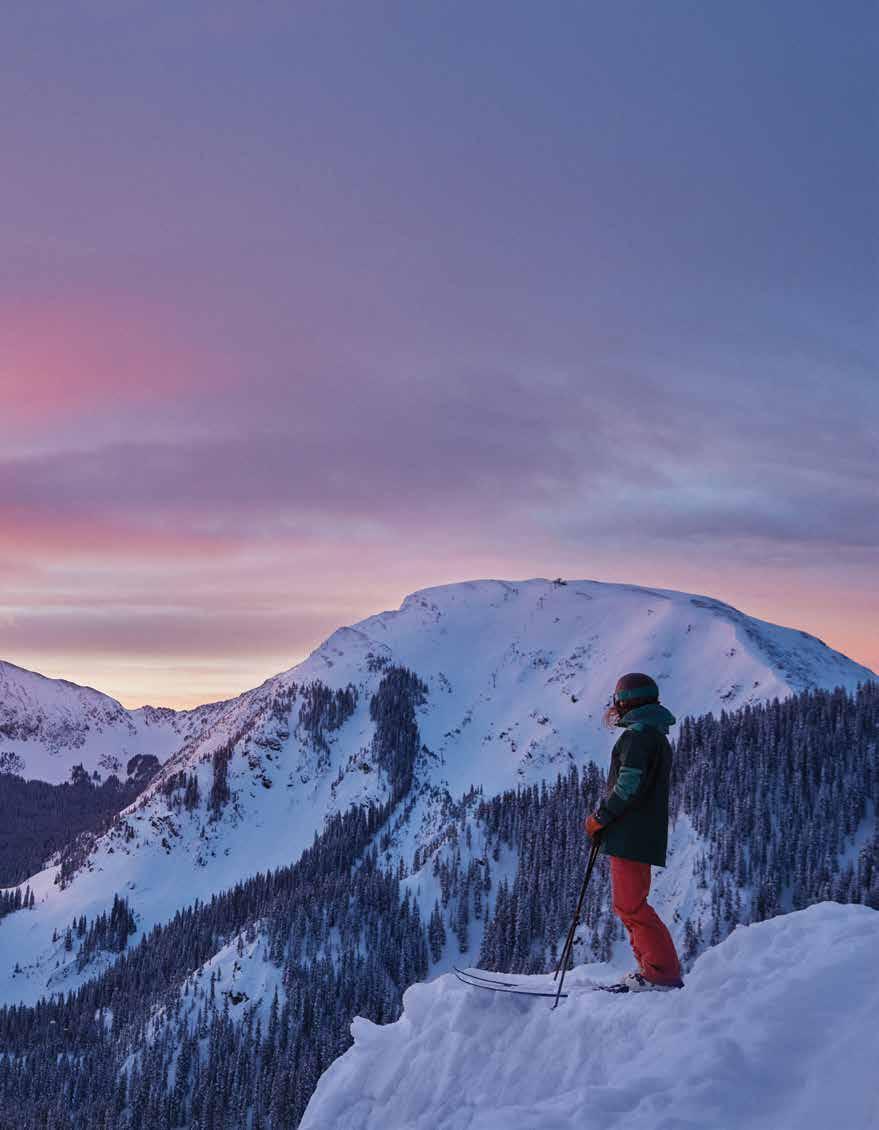
©Taos Ski Valley 2022
SNOWTALENT


CAROL GAMARRA Stylist
Madrid-based top fashion stylist Carol Gamarra is not a skier, but after many editorial shoots with SNOW, she’s considering it. To dip her toe in, she plans to start with après ski in Sierra Nevada, Spain, high in the hills above Granada. Los Jamones is on her wish list for an Aperol Spritz by a crackling fire.
 ANDREW
ANDREW
FINDLAY
 Writer
Writer

Vancouver Island, BC-based Andrew Findlay has a few destinations on his winter ski list. “So far, I have the tiny Balkan country of Montenegro, the Ötztal Alps of Austria, Hokkaido (because shamefully I’ve not been yet), Morgedal, Norway (the birthplace of ski pioneer Sondre Nordheim and of modern skiing), and Revelstoke’s new boutique Flying Moose Chalet to use as my power HQ.


 MATTIAS FREDRIKSSON Photographer
MATTIAS FREDRIKSSON Photographer
Mattias Fredriksson looks forward to returning to the Swiss Alps and skiing in the Engadine Valley, Andermatt, and the little gem of Arolla in Valais. “I have not been there since 2020 when Leslie Anthony and I produced the Andermatt feature for SNOW, and as much as I love to ski the deep pow at home in Terrace, BC, nothing beats the vistas of the Alps and the ski culture there.”
LESLIE ANTHONY Writer
Whistler-based journalist Leslie Anthony hopes to ski a few places in his home province of BC, some of which have seen big changes over the past few years—like Sun Peaks and Red Mountain. “I also want to get back to Japan and Italy for a single odd reason—I was chased out of both countries by the start of the pandemic in the Spring 2019 and it feels, if there can be such a thing, like unfinished skiing.”

26 TALENT
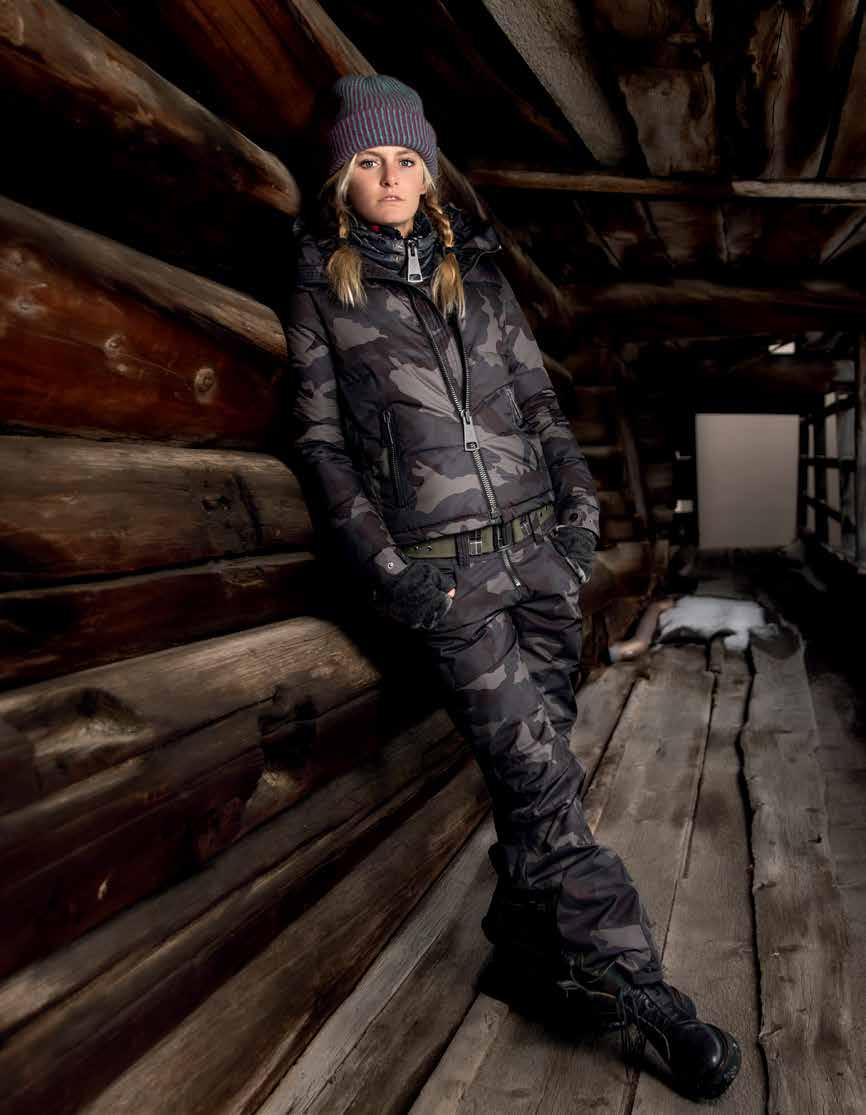
GAMEON
High speeds, strapping thighs, and the febrile atmosphere of those devoted to being the best at what they love. My first day of the season was rich with it all. And I’m certain it’s a happy harbinger for the winter ahead.

My late-November day at Lake Louise was crowned by not one but two magic moments. First, the chance to watch up-close the fastest men on skis – Kilde, Odermatt, Feuz, Paris – at a World Cup Downhill is a performance you just have to experience. The skiing—more piloting than skiing—involves 85mph trajectories over glistening water-injected tracts of bullet-proof ice, a mind-bending undertaking. The sound alone will curl your hair. When that’s over and less than two minutes later the racer crosses the finish line, the hugs, handshakes, and highfives they give to both their fellow countrymen and opposing ones are proof that ski racing is actually a team sport at its core.
After the race and a few runs of our own, we stop for a drink at one of the finest ski hotels in Canada and among my favorite anywhere. Tucked into the tiny village of Lake Louise, The Post Hotel is a Relais & Châteaux haven of haute log-cabin loveliness where, over a fine spread of Kaffee und Kuchen in front of the crackling fire, Swiss-Canadian provenance prevails. The lovely Michael Schwarz, The Post’s second generation “innkeeper” (as his modest uncle Andre liked to call himself) captures the spirit of skihood in one breath. “Welcome, you are in the right place.”
May your winter be filled with just that. With an alpine world filled with tradition, hospitality, and some pretty hot skiers in catsuits, wherever we ski, we’re all there. In the right place.
Leslie Woit Editor-in-Chief

28 EDITORS LETTER







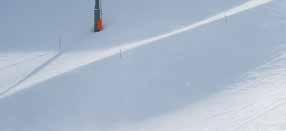

























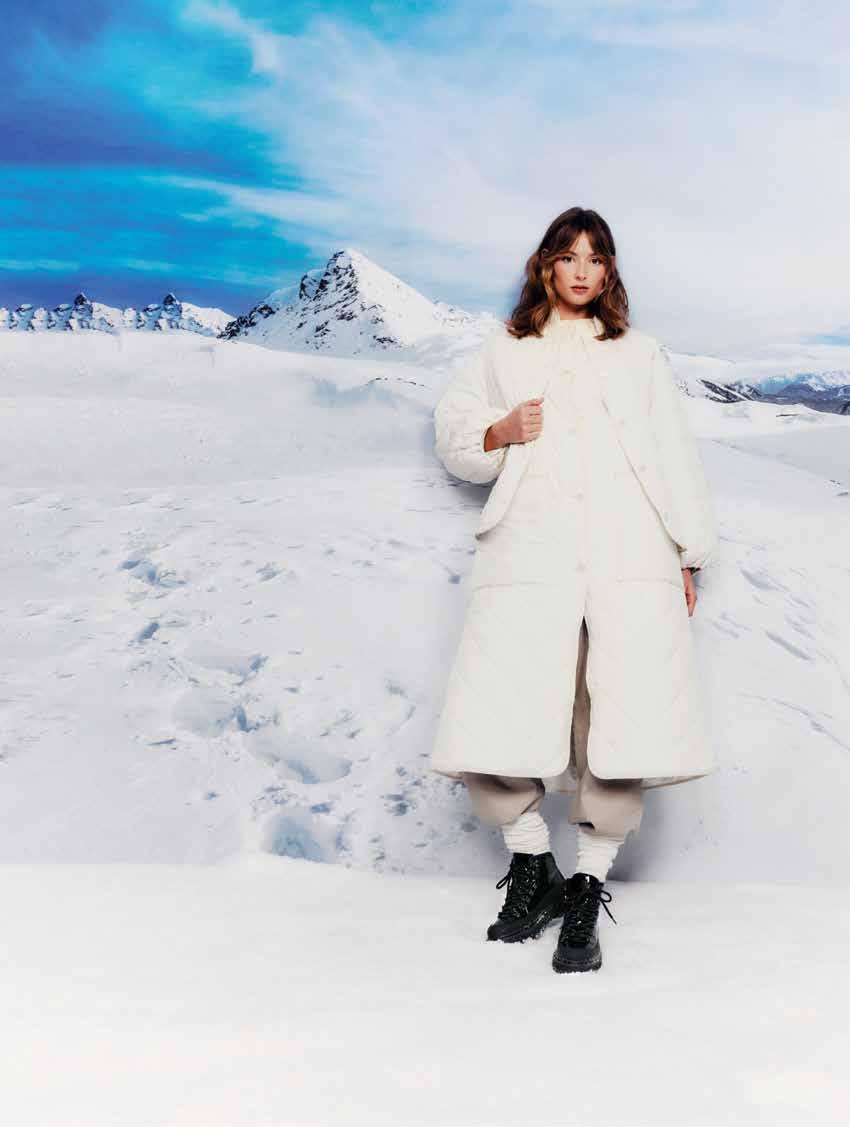

BORN IN OSLO, WORN OUTDOORS us.monofoo.com AVAILABLE AT
BY MATTIAS FREDRIKSSON

SNOWFLURRIES
PHOTO
Join the Club
When the glittering resorts of Courchevel and Méribel play host to the Alpine World Ski Championships this February, there are no Quonset huts in their masterplan. In true Courch’ style, arrangements for the global showdown of the 600 fastest men and women on skis are teed up for impact maximal. A new, exceedingly treacherous downhill course has been cut from top of Le Loze to the base of Le Praz, a two-mile black run with an average pitch of 30 degrees. When now-retired World Cup champion Aksel Svindal reviewed the super-fast and technical L’Eclipse piste, his view was clear: “I’m glad I’m not racing anymore!” As the likes of Aleksander Aamodt Kilde apply the brakes to their 90mph flight paths at the finish line, they’ll be met by some 20,000 fans and the fanciest piste-side club house on the World Cup circuit. Courchevel’s Ineos Club House–a shiny complex housing a high-tech gym, glassy Champagne-stocked viewing bars, and room for 1,000 pairs of skis worn by young local racers in training–was bankrolled by Jim Ratcliffe, billionaire chairman of Ineos chemicals group. Visitor access to the $19-million super-shack is possible through various hospitality packages, including VIP viewing of the races as well as the chance to ski with the best in the world afterwards. Of course, there’s VIP and then there is Courchevel-VIP. The penthouse floor is reserved for the newly inaugurated members-only Ski Club of Courchevel, refuge for a few dozen blue-blood regulars to partake in panoramic dining, drinking, and general l’art de vivre amongst their own – a mélange of oligarchs, oil barons, and Monegasque royalty. Membership fees help fund the development of local racers whose ranks include Alexis Pinturault, the most successful French skier in World Cup history.—Leslie Woit
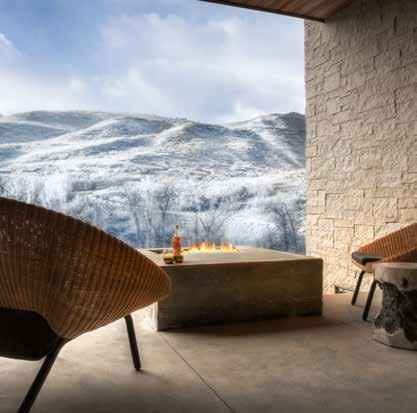

Blue Sky Thinking
Western ranch life has a mystique of its own, a freedom-rich world of fly-fishing, wandering, and spirited horse-riding across untamed lands. This idyllic state of mind is ours, within striking distance of both Deer Valley and Park City skiing. A few years’ fresh to the Utah scene, The Lodge at Blue Sky is a sprawling arrangement of private suites speckling a vast tract of land covering some 3,500 acres. Accommodations are in elegantly appointed suites, some with outdoor fireplaces, fitted with magnificent floor-to-ceiling glass walls that overlook a panorama of private mountain terrain. Each suite is within a short walk of not only the stunning infinity pool and destination wellness spa, but also the starting point for an embarrassment of outdoor riches from snowmobile-assisted ski touring, clay shooting and sleigh rides, to Nordic skiing, yoga, and alpine art classes. And, no matter the weather, each Blue Sky day is bookended by some stellar cooking from new executive chef Jason Franey, a three-time James Beard Award nominate and Eleven Madison Park alumnus.—L.W.
FLURRIES


#MOMENTMAKERS Shop the new collection at perfectmoment.com
Raising the Bar
Do drafty chairlifts and rattly trams spoil your vibe? The Swiss have the answer. Lift the mood of your Grindelwald ski day by hiring your own VIP gondola cabin. The new VIP Gondola Eiger Express, a truly pimped-up golden carriage, is lushly furnished with red-leather swivel armchairs for eight, soft floor lighting and hundreds of starlit skylights, and, quite obviously, a red carpet. Of course, it wouldn’t be right to not have the Champagne bar, if only to nurture the

buzz from the first cheeky glass you’re served in the Platinum Lounge before boarding, and to lay a proper foundation for the exclusive Ice Bar visit at the top. Then, when all those earthly pleasures are properly addressed and you’re well installed at 11,332 feet atop the Jungfraujoch, there’s still the matter of all the heavenly skiing amidst the linked resorts of Grindelwald and Wengen to enjoy. Who says climbing the Eiger is a chore?—L.W.
Put a Fork in It
Want wine? Summon the sommelier. Love cheese? Do the same. Fondue is serious business in France and Megève’s splendid five-star Hotel Le M stirs in a healthy measure of fun, too. Resident expert cheesemaster Thomas Lecomte will appear tableside to advise on best composing your own unique fondue—just as any proper sommelier would guide us through an imposing carte des vins. Choose a fondue of variety or a fondue of assembly according to mood and palate, your own unctuous blend to be paired with bread, vegetables, and perhaps fruits, using only the finest cheeses from Savoie and Haute Savoie, including Manigodine, Beaufort, Abondance and, for extra sparkle, a liberal splash of Champagne.—L.W.

FLURRIES

Fun foodie fact: per capita, Lech-Zürs claims the highest density of award-winning restaurants in all the skiing realm. How do they do it? Perfectionism is a distinguishing feature here—but so too is an unparalleled culture of hospitality that defines this storybook valley. We tip our toques to the elegant dining rooms and stylish Stuben in this snowy corner of the Vorarlberg—of which there’s no better example


Lech, Expect the Unexpected Angle of Repose
mind). But here’s the catch: Lech is more than just crisp linens and haute cooking. Introducing Europe's highest skiin barbecue restaurant, Trittkopf BBQ Station. What better, more surprising, use for a disused high-mountain cablecar station than as a temple of pulled pork and slow-cooked ribs? Perhaps it’s the altitude but we’ve never tasted better. Also vying for first in the Lech Surprise Factor competition is The Yurt. A pop-up must for every skiing nomad, this authentic handmade Kyrgyzstani hideaway is the hot-spot for a glass of Perrier-Jouët followed by a round of Roku Negronis, all served to a beautiful fur-clad clientele draped over comfy kilim pillows and bathed in flattering firelight. Beats the usual mug —L.W.
Greg Von Doersten has recently released his first fine art coffee table book, Angle of Repose. Set entirely in Jackson Hole, WY and the surrounding mountains, it is a story driven collection of stunning snowsports photography. Formerly Powder Magazine, Von Doersten shares the art of capturing the moment on snow and in the mountain environment. He has been shooting in Jackson and around the world since the late 1980s. Jimmy Chin writes, “I hope the photos in Angle of Repose will inspire you , as they did me, to “drop in” to a place of selfdiscovery in the mountains and appreciate the wild places that skiing can take us.”—Barbara Sanders

FLURRIES

AVAILABLE AT AZTECHMOUNTAIN.COM AND FINE RETAILERS WORLDWIDE
Every so often a book comes along you’re certain was written solely for you. The Hitchhiker's Guide to the Galaxy Bridget Jones’s Diary, Zen and the Art of Motorcycle Maintenance When Harry Potter’s ghostly mother reached for his hand in the dark forest and whispered, “You’ve been so brave, sweetheart,” surely every frightened child’s thoughts were the same: Is she speaking to me? For skiers—for soulful skiers—that book might be John Irving’s latest, The Last Chairlift Skiing anchors the novel. From Aspen to Stowe, from St. Christoph to Bromley, The Last Chairlift dips in and out of iconic ski spots and touches on special moments in skiing’s history. Toni Sailer is in this book. So is Hannes Schneider. Irving hails the bravery of the 10th Mountain Division. And there are umpteen nostalgic mentions of ski racers—tragic and victorious, real and imagined. The narrator, Adam, is born to Little Ray, a “girl jock” in the 1940s who fails as a racer—she’s too small!—and so, turns to ski instructing. Little Ray is so reverential of Austria and the Arlberg technique that she’s distracted from mothering. Teaching skiing steals her away from Adam for six months every year; he’s left to be raised in small-town New Hampshire by a cast of odd, Irving-esque characters and ghostly figures. Worse, he’s left pondering where he was conceived—Hotel Jerome?—and, at the crux,
Irving’s Ode toOld School
who his father might be.

Still, The Last Chairlift is not about skiing. In true Irving style, the book wrestles with much larger themes: gender identity, the Vietnam War, wedlock, indignities of aging, stultifying religion, wealth vs. poverty. As in nearly every Irving novel (The Cider House Rules, A Prayer for Owen Meany) this one features a private boys’ school, a rambling old house, and characters both very big and very small who act strangely yet somehow normally. Everyone is weird in an Irving novel, and so they should be.
Reviews point out the book is long—it is. At 700-plus pages The Last Chairlift requires commitment and perseverance. Around chapter 30 of 53, readers might question where Irving’s editors disappeared to; brevity is not a strong suit. Reading The Last Chairlift is more like turning your skis down an old-school ski run. There are twists and turns, it meanders all over the place, and it delivers you to a spot so far down the mountain you have to take three fixed-grip triples to get back to the summit. And yet, if asked if the time it took to ski it was worth it, you might say yes, if only for the nostalgic run down a trail of memories. Best of all, the soulful skier within you will be left wondering: Was he speaking to me? Lori Knowles

38
FLURRIES
Experience the GRANDEST ESCAPES the




Naturally spectacular, Fairmont Chateau Whistler delivers true mountain luxury with 8,100 acres of the finest skiing in North America right at your doorstop.
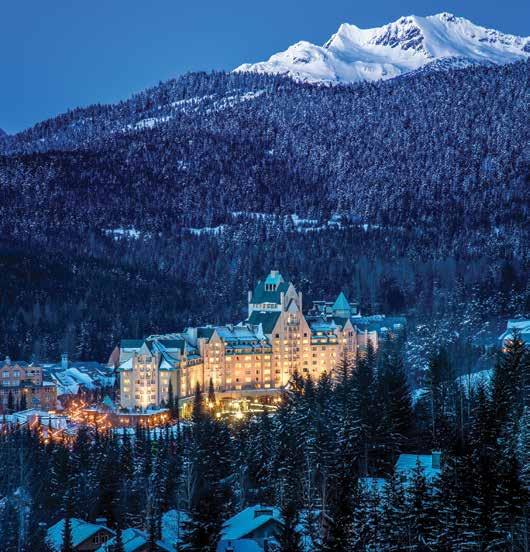
First chair, to last call ― with the Fairmont Chateau Whistler as your basecamp, Whistler becomes your backyard to explore.

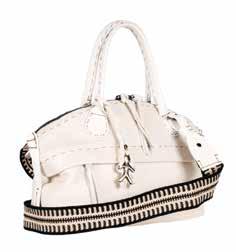








STYLE
Goldbergh
Ovcio
WHITE OUT CLEAN LOOKS IN 22/23
Henry Beguelin Rossignol Ogier Gucci Canada Goose
Moncler
Mono
Surefoot’s proprietary fitting process fits you into the most comfortable and best performing boot you could imagine, immediately. With 3D imaging, custom fit orthotics, memory foam injected liners, and an integrated heating system, you’re ready for the best skiing of your life– in just over an hour. Whether you’re a beginner or a seasoned expert, Surefoot has the right boot for you. Come in and experience the Surefoot difference today.

Jack Affleck

SKI THE SUREFOOT DIFFERENCE COMFORT + PERFORMANCE NEVER EXPERIENCED
IN SKI BOOTS
BEFORE
THE COMFORT IS IMMEDIATE. THE PERFORMANCE MAKES A DIFFERENCE IN EVERY TURN.
Park City Canyons Deer Valley Vail Beaver Creek Aspen Snowmass Copper Keystone Breckenridge Steamboat Sun Valley Mammoth Palisades Tahoe Los Angeles Killington New York City Whistler
Verbier Val
Oslo
Denver
Northstar
PHOTOGRAPHER:
COMING SOON Vancouver
d’Isére
London
Jackson
Beauty Slopes on the
The ski day is precious, time flies by quickly and before you know it, après is calling. The après professional does not want to lose time running home to beautify after skiing. These four products will keep you looking your snow bunny best. Chair or gondola applications are a breeze and beauty is only a lift ride away.
BEAUTY RADIANCE

ALEPH
Aleph offers a skier and traveler’s dream set of products. All fit slimly into your pocket and can be applied with the tip of your finger. Started by Emma Peters, the name Aleph represents the concept of oneness which led her straight to the first letter of the Hebrew alphabet— Aleph—an all-encompassing expression of divine oneness. It is created, owned and operated in New Zealand and is toxin free, GMO free, and vegan. We love the Radiance Balm because it is light, bright, and multi-dimensional. It’s a perfect eyeshadow, but it is also a great cheek tint.
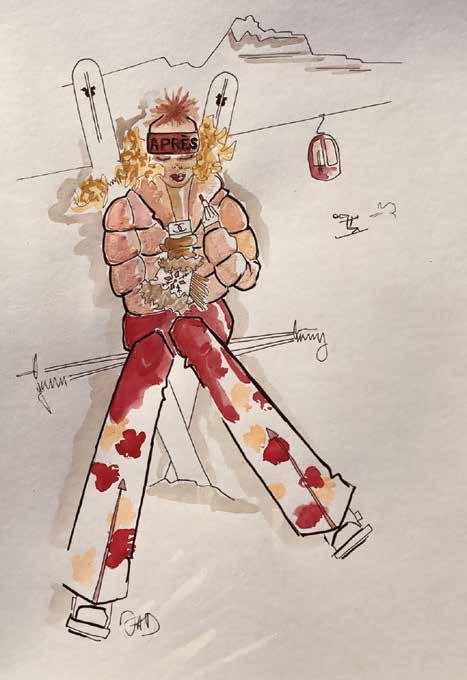
42
BEAUTY
ALEPH
ski goggles don’t work as well on the beach“
– Lindsey Vonn

“My
Visit us to see our new sunglass collection
MAD HIPPIE

Mad Hippie is on a mission to “buck the cosmetic establishment”. All of their products are naturally based, made with sustainable practices and an ethical ethos. The daily protective serum is a clear mineral sunscreen with an SPF of 30+. It will hydrate and nourish your skin. It’s key to use a mineral sunscreen rather than one of the many chemical pore blocking brands. Start your day with an application before skiing. For on the slope usage, the tube is small and fits in your parka pocket to reapply at lunch.

SEABUCK WONDERS GLOW
Like a large glass of water for your skin, this light natural oil is made from plants and flowers with zero synthetic chemicals. Music to our ears! “Wildcrafted” from the Tibetan Plateau, its seaberry seed, camellia, and rosehip oil hydrate and support the cell walls within the skin. Your face is nourished by cosmetic-grade avocado and sweet almond oil. Absolutely delicious, it’s your go to serum on and off the slopes.


MIND SKINCARE
This Columbia-based skincare company may just convince you that CBD is the fountain of youth. Founded by Paulina Vega, a former Miss Universe, its products combine top-quality botanical extracts with organic CBD oil from the brand’s own sustainable farm in Columbia. Some of CBD’s skincare superpowers include reducing the appearance of wrinkles, protecting against free radicals, and removing impurities that clog pores. The Long-Lasting Hydrating Face Mask has become my secret weapon in moisture-sucking high-altitude destinations. Crafted from CBD oil, shea butter, and acquabio 3R (a plant-based extract known for regenerative properties), it left my skin looking plump and dewy even after a day on the slopes. The Eye Cream is as essential as a strong cup of coffee after a big night out. Its magic formula of CBD oil, plumping hyaluronic acid, and extracts of Ceratonia siliqua seed and sea chamomile erase puffiness and a metal applicator tip softens fine lines. — Jen Murphy
BEAUTY

Your Personal PT
by JEN MURPHY
TheraBody debuted its game-changing massage gun in 2016. The latest iteration, Theragun PRO Gen 5 ($599) is now 20 percent quieter and has a builtin OLED screen that displays easy-to-follow routines to help with recovery and even sleep. I’m the first to admit I skip stretching and warm-ups on powder days and my foam roller tends to gather dust. But I can

use the Theragun PRO Gen 5 while I’m sipping morning coffee, at the airport, or even in the passenger seat during the drive to the mountains. With six attachments including a thumb and micro-point for trigger work, it rivals a human massage, particularly if you can get a friend to reach the tough spots. It melts away knots and aches, and just a few minutes a day has helped improve

46
If only we could travel with our own masseuse, chiropractor, and PT team like the pros. We test the next best thing.
TECH


Sem título-2 1 24/10/2022 13:56
ZERO EVO JACKET
my mobility. If you’re a lifelong skier, you’ve probably suffered a knee injury. RecoveryTherm Hot and Cold Vibration Knee ($399) is like a mobile physical therapist ready to streamline the arduous heat, icing, and massage routine. Ideal for anyone coming off surgery or nursing a nagging strain, the brace-like device is lined with Germanium fabric that naturally emits far-infrared light to help increase circulation. The signature Cryothermal Technology applies fast and effective contrast therapy to speed-up healing.



48
TECH
“Germanium fabric naturally emits far-infrared light to help increase circulation”



ARC’TERYX ALPS & METERS AZTEC BOGNER CAPRANEA DESCENTE FIRE + ICE 208-622-2021 208-622-6146 FRAUENSCHUH FUSALP GOLDBERGH HEAD HOLDEN HOUDINI HALF DAYS KJUS MONCLER MOUNTAIN FORCE PERFECT MOMENT PARAJUMPERS ROSSIGNOL TONI SAILER
BetterLivingwith Ski-BD
The new wonder ingredient of the wellness industry is smoothable, drinkable, and stickable.
by JEN MURPHY
Could CBD be the DIY cure-all for skiers’ ailments? From cracked, wind-whipped skin to arthritic aches and pains, many think yes. An oil derived from the cannabis plant, cannabidiol (CBD for short) is packed with antioxidants and anti-inflammatory agents. We put products from some buzzed-about companies to the test.
DAYTRIP
First, it was flavored bubbly seltzers that took off. Then they were spiked with booze. Now seltzers are being infused with CBD. One of the coolest new brands, California-based Daytrip, stands apart for its use of terpenes—a little-known compound found in the essential oils of plants. Daytrip has developed a proprietary blend of botanical terpenes inspired by the profile




of classic cannabis sativa strains, prized for their uplifting, energetic, yet calming effects. Combined with Hemp CBD, the formula energizes the senses while relaxing the mind. When added to seltzer, you get the ultimate combo of refreshing and chill in six fruit flavors and only five calories. An interesting alternative to a post-ski beer.

50
WELLNESS
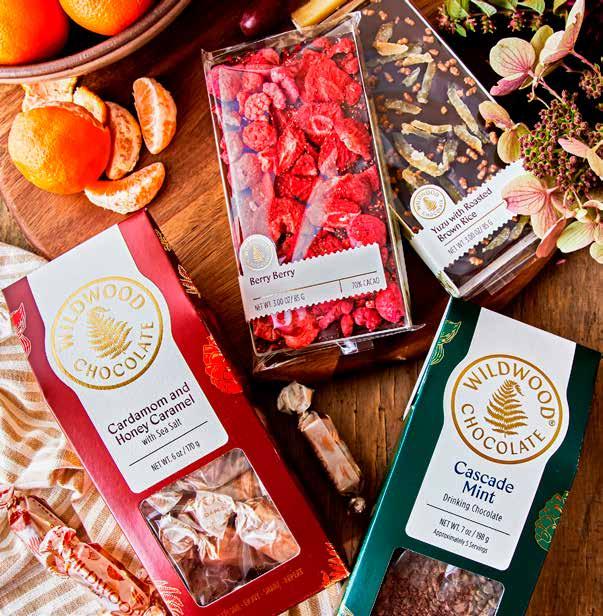
ASPEN | VAIL | JACKSON HOLE | SUN VALLEY | STOWE | MANCHESTER WILDWOODCHOCOLATE.COM HANDCRAFTED, AWARD WINNING CHOCOLATE AND CONFECTIONS FOR A SWEET SEASON
VERMONT PURE CBD

This Shoreham, Vermont-based company prides itself on quality, growing USDA certified-organic hemp on its sustainably managed farm. Harvested hemp flowers are extracted on-site to produce the Full Spectrum Organic CBD Oil that goes into a dozen-plus products—from salves and tinctures, to sweet treats like caramels. Small-batch salves come in jars or travel-friendly sticks, handcrafted with Full-Spectrum active CBD oil, almond oil, local beeswax, coconut oil, shea butter, and olive oil. The texture is silky rather than oily and provides relief to achy muscles. Unlike some CBD products, these have no funky cannabis odor yet, if you do crave aromatherapy, three scents include an invigorating combo of wintergreen, camphor, and pine. The tinctures come in seven strengths ranging from 100mg to 3,600mg, intended to help relieve stress and anxiety. I had been relying on a nightly glass of wine or two to calm my nerves. The switch to orange-tincture spiked seltzer had the same effect but didn’t leave me feeling groggy the next morning.
FLEX POWER
No one wants to wreak of medicinal Bengay at après ski. Thankfully, Flewpower makes fast-acting muscle and joint pain relief products that are all-natural, scent-free, and vouched for by Olympians and NFL stars. Flexpower Warm lotion therapeutically warms the skin while soothing sore muscles and continues to activate throughout the day. Flexpower Soothe lotion is described by customers as a magic potion that helps mellow stiff joints and muscles. I slathered it on my calves and quads before heading to the mountain and found it as effective at loosening up my muscles as a preski foam rolling session. Natural anti-inflammatory ingredients include arnica, turmeric, eucalyptus, and CBD, and a dose of vitamin E goes for extra hydration. The Cool Bath Salts, spiked with Epsom and sea salts and sunflower seed oil, are so restorative I found myself skipping post-ski hot tub sessions in favor of a home soak.

SUMAFORTE
If only recovery were as easy as a hot tub sesh and beer. Most of us put in the time to train then neglect what sounds easy: rest. Sleep becomes a bigger struggle when hopping time zones from the Rockies to the Alps. Top athletes turn to products from new plant-based recovery company, SummaForte, to help maintain equilibrium. SummaRest—a melatonin-free, all-natural sleep aid made with CBN (a cannabinoid with restorative sleep benefits), CBD, and calming botanicals such as valerian root—is the perfect pre-bed assist to mellow my mind in just 15 minutes. Many athletes and weekend warriors, me included, rely on kinesiology tape to help play through nagging injuries. SummaTape delivers CBD and menthol through the skin to help performance and healing by stimulating blood flow in inflamed areas. An advisory committee that includes a former team physician for the U.S. Ski Team, cannabinoid researchers, and a top orthopedic doctor approve every product so it’s no surprise the company’s earned a devoted following in just three years.

WELLNESS


LIQUID
Love

BOTTLE
A new tequila embodies the spirit of skiers by going down smooth and fast by LESLIE WOIT
PHOTO BY ANTONIO CORDERO



ON YOUR NEXT ASPEN RETREAT Pursue the Peak Experience 970.544.8001 • aspensignatureproperties.com • 400 East Main Street, Suite 101, Aspen, CO FEATURED PROPERTIES: TOP: Maroon Green Country Charm | LEFT: Eco-Friendly West Side Victorian | RIGHT: Quiet Meadowood Estate LUXURY VACATION RENTALS • CONCIERGE SERVICES • FULL-SERVICE REAL ESTATE ©2022 BHH A liates, LLC. An independently owned and operated franchisee of BHH A liates, LLC. Berkshire Hathaway HomeServices and the Berkshire Hathaway HomeServices symbol are registered service marks of Columbia Insurance Company, a Berkshire Hathaway a liate. Equal Housing Opportunity.
It’s official. Your Champagne is old school and that bottle of whiskey belongs in the library.
Tequila is now the most popular drink for aperitif, digestif, and whatever falls between. America is the world leader in tequila drinkers, where consumption has grown by over 40 percent in the past five years. Nowhere is the trend more prevalent than in mountain restaurants, heli-lodges, and athome fireplace soirées—be it in a Margarita, a Mule, or straight up and straight down swift as a racer on freshly waxed boards.
And now, there’s a premium tequila just for skiers. Originating in the verdant hills of the Free and Sovereign State of Jalisco, Mexico (the authentic home of tequila), SNOW Te-Ski-La embodies the skier’s spirit, a spirited folk typically
unfazed by steep lines or strong drink.
There’s more behind this luxury brand than just the name. The magic begins far from the snowy slopes of Aspen or Andermatt, some eight miles from a towering volcanic crater in Amatitan, Jalisco, where vast sun-soaked
and mineral-rich fields provide the perfect climate for this clear beauty.
“The soil is rich in minerals and literally sparkles like snow on a cold, sunny day,” says Maestro Tequilero Jesus Correa. It makes this Tequila Cristalino Reposado a delight to the palate.” Just what is a Cristalino Reposado? It’s barrel aged for three to six months and then filtered to snow white. According to a prominent trade journal, “Cristalino Tequilas are expanding the category’s audience since it offers the depth of flavor and complexity from an aged spirit, coming from maturation in the barrel, with the versatility and brightness of a Blanco Tequila that mixes well in cocktails”.
You had us at sparkles, Maestro.
These fragrant blue agave crops,

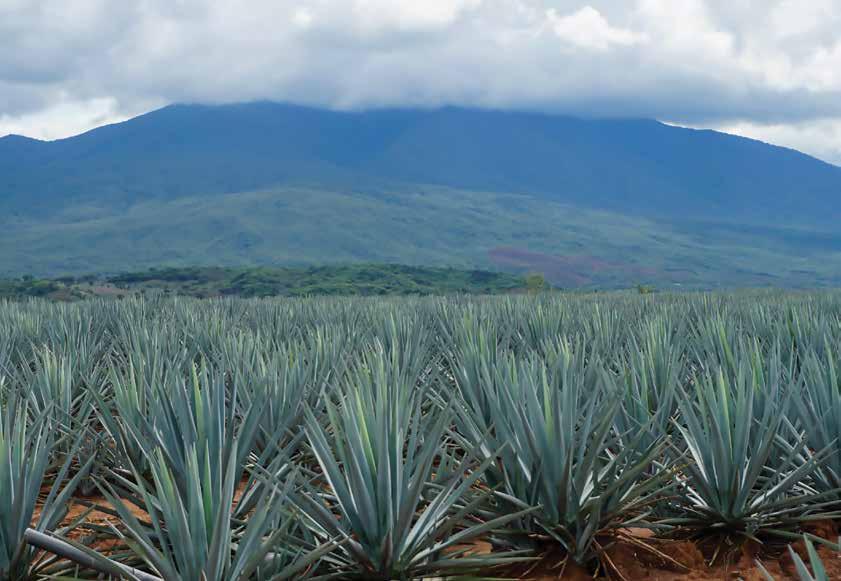
56
BOTTLE
“SNOW Te-Ski-La is created with the perfect combination of flavors from agave plants grown at the foot of a volcano.”

naturally fertilized by volcanic minerals, also bear the stamp of honor— Tequila Denomination of Origin. Because of its semi-arid environment (the area receives rainfall only two to three months of the year), and consistently warm temperatures, their agave crop is among the best. “It inclines towards delicate herbaceous notes that are not too sweet— this gives us a versatile profile and more possibilities to create unique flavors,” explains Correa.

The special raw materials are eventually sent to the distillation process—a crucible of chemical- and chlorine-free artesian well water and potent volcanic minerals. And when the tequila is ready to be bottled, the same care and consideration are extended to the local community. “We rely on the work of the women of the community,

58
BOTTLE
”
PHOTO BY ANTONIO CORDERO
who are responsible for labelling and handpackaging the final product. We also cover many other areas of work to support the economy of the women and their families.”


Spearheading the initiative closer to home are two women just as committed to nurturing a sense of community and to filling its glasses, both physically and spiritually, with a splash of marvelous. Between them, founders Katrina Ilona Johnson and Barb Sanders have conquered peaks and pistes on most every continent, graced many a ski magazine and— lucky for us—sampled an international research institute’s worth of alpine tipples, local elixirs, and body shots. So when that beautiful frosted bottle of Te-Ski-La lands on your mountainside lunch table, give it that extra swirl of affection it deserves. Because it’s après, and it’s time to do what skiers do best. As the Te-Ski-La manual says, “Make tracks, make laughs, make it SNOW Te-Ski-La”.

the Soul of Sun Valley

In search of authenticity, we make turns in the tracks of Hemingway, Gable, and Bergman
by AMY TARA KOCH
PERFECT PLACES
PHOTOGRAPHY COURTESY OF SUN VALLEY SKI RESORT
675 Main Street Park City, Utah, 84060 wenorwegians.us

FLAGSHIP STORE
Last season, it dawned on me: top American ski resorts had developed an eerie homogeny. It wasn’t the terrain—that was as nuanced as ever. It was the arrival of splashy restaurants imported from Los Angeles and Miami, some cheerily charging $42 per plate of pasta. The evaporation of bar menus, that mountain town staple for affordable small plates offered during happy hour. And the quiet closure of family-run businesses to make way for global luxury brands. The result was clear. The uptick in flashiness invited a sameness that eroded the town’s locals-live-here charm.
An outlier is soulful, Smoky-rimmed Sun Valley. America’s first destination ski resort which has changed hands only



three times since it was founded in 1936, is owned by the Holding family who has flatly refused to glitzify their Sawtooth Mountains perch. Sun Valley has no five-star hotels, no fancy Chanel boutique, and no ski concierges to shuttle gear to and from the mountain. Old school charm abounds, from quaint pull carts to transport ski gear from the shuttle to the gondola, to on-mountain eateries that are rife with vintage mementos and a style best described as anti-alpine minimalist. Thanks to a hillside ordinance to protect views, wildlife, and natural features of the landscape, you’ll encounter no private on-mountain mansions (a few structures were built pre-regulation era) as building on Ketchum’s hillsides and ridgelines with more than 25 percent
grade are restricted.
This absence of ostentation mixed with a vibrant, engaged community imbues this mountain town with a rare strain of alpine fairy dust. “There is a lot of wealth out here, but rich people and celebrities want just to ski and blend in. Drew Barrymore shops here and Carole King pops in to donate clothing. Nobody pays any attention,” explains Craig Barry, Managing Director of The Gold Mine, a thrift store selling everything from skis to Moncler sweaters, to the benefit of Ketchum’s The Community Library. That Ketchum champions its small, independent businesses is why Jacob and Tara Frehling’s groovy coffee and fashion shop Maude’s Coffee and Clothes and dozens of shops and cafés such as Rickshaw, Raspberries, Vintage, and Cookbook can thrive. “Being an entrepreneur in a place that is passionate about
62
PERFECT PLACES

In Aspen, CO MARCH 3RD – 5TH Hors d’oeuvres & Drinks Will Be Served All Weekend at Christie’s International Real Estate Aspen Snowmass 520 E Durant Ave. Suite 205 | Across from Gondola Plaza ChristiesAspenRE.com | 970.544.5800 WARM UP AT OUR FIS SKI WORLD CUP HOSPITALITY SUITE
promoting local businesses is a joy,” explains Cassie Abel, founder of the Sun Valley-based activewear company for women, Wild Rye.
Celebrity culture? Here, Hemingway carries more sway than any Housewife or bold-faced diva thanks to a genius PR move by the resort’s GM in 1939. When Steve Hannagan invited the macho author for an all-expenses-paid vacation in exchange for photos of Papa working (he edited For Whom the Bell Tolls from room 206, where it is rumored that he shot a duck for quacking too aggressively) and living his celebrated
outdoorsman life. Duck hunting at Silver Creek, chasing antelope and elk in the Pahsimeroi Valley, fishing along the Middle Fork of the Salmon River— it all helped put the newbie resort and central Idaho on the map.
In Sun Valley, legacy is king, so it is not surprising that Hemingway’s haunts remain popular. There’s The Ram, still serving “heritage dinners” featuring dishes from the restaurant’s 80-plus years (lamb from 1941, Hungarian goulash from 1966, pork schnitzel from 1982) complemented by live piano playing; the wood-paneled, lively Duchin Lounge (both within the Sun Valley Lodge) for whiz-bang, Idahoinspired cocktails like Pioneer Cabin, a blend of Buffalo Trace Bourbon, Carpano Antica, Averna Amaro, Frangelico, and orange bitters. Hemingway had a standing table at The Christiana (now Michel’s Christiana, owned by Michel Rudigoz, former coach to the U.S. Women’s Ski Team)and it before has changed little. Its classic French fare and killer martinis continue to delight diners who gather round time-worn leather banquettes beneath historic ski photo studded walls.
Pioneer Saloon remains the convivial Wild West watering hole of yore. A birchbark canoe hangs from the ceiling. Heads of deer, elk, and bison peer down at guests. And Hemingway’s 1953 Winchester Model 21 twelve-gauge shotgun is on display.
Hats off to Sun Valley where standout skiing and a quintessential mountain town endure, without a single Stetson-clad influencer to be spied in the sights.


64 PERFECT PLACES

TheWomenareBackon theWorldProSkiTour
One of ski racing’s most exciting events, with lucrative prize money up for grabs.

It’s a field stacked with World Cup stars, national team members, college standouts, and Olympians both future and decorated. And now a whole new stack of talent is joining the fray.
Last year, women returned to the tour for the first time since the late 90s, a quarter of a century ago. They were welcomed back with equal prize money, with Paula Moltzan taking home over $50,000 from the World Championships in Taos alone. But this year, the playing field is truly even, says Jon J. Franklin, CEO of the Tour. The women’s events have been expanded to a 16-race circuit. And women will be racing the same courses.
Over $500,00 is up for grabs for the season. The first-place winners in Taos will each be awarded $20,000, plus each
overall world champion takes home a $25,000 bonus. The money isn’t the only reason the Tour is attracting so much talent. For some, it’s a chance to race against a childhood idol. For others, it’s an opportunity to resurrect their career. And for stars like three-time Olympian Resi Stiegler, who made a comeback to the ski racing scene last year, it's a fine way to have a lot of fun.
With roots dating to the late 1960s, the Tour has long attracted elite racers. Disbanded in 1999, it made a comeback in 2017. The now 16-event circuit has comeback stronger than ever. Franklin says the World Pro Ski Tour isn’t designed to compete with the World Cup circuit, but rather offer an alternative avenue for race competition. It’s a complementary competition, much like Formula One is to NASCAR, he
66
SPONSORED
explains. A field of 32 racers earn a spot based on qualifying times. Racers are then seeded in a NCAA March Madness-style bracket, competing next to each other on a super-slalom type course with pro-style jumps. The winner advances based on time differential. The side-by-side racing format is unique: the racer standing in the next gate could be two-time Olympic champion Ted Ligety.
Paula Moltzan has commented that the World Pro Ski Tour is in the same realm as the World Cup or Olympics. And after winning last year she also noted that she hadn’t had more fun all winter. Like last season, the tour expects more than 25 Olympians from a dozen countries to compete—including big names like German Olympic medalist Linus Strasser and Canadian brothers Erik and Jeffrey Read. Ligety has vowed to be back this season coming off back surgery. There are even rumors that four-time Olympic medalist Julia Mancuso is considering an appearance. The action also attracts stars to the sidelines. Last year, Bode Miller attended two races and legends such as Billy Kidd regularly participate in the social activities surrounding the events. “It’s become a scene on and off the slopes,” says Franklin.


The Flying Moose
At the end of the road but out of this world, this heli-ready chalet soars in Revelstoke, British Columbia.
by LESLIE ANTHONY
You’d be forgiven for conjuring a cartoonish character when you hear the phrase “flying moose.” While it’s the perfect pop-cultural meme for a kid’s show super-hero, with the Flying Moose Chalet the phrase has an entirely different meaning—a semiotic for comfort, convenience, and the kind of intimate luxury it’s hard to engineer into large wood-beam structures.
Set at the base of Revelstoke Mountain Resort, the Moose is the final edifice on a street of large private group chalets, quietly outdoing them all: eight beautifully appointed guest suites with private bathroom that can accommodate up to

20; a lounge with projector screen; a fitness and massage room with steam shower; an outdoor sauna, large hot tub and infinity pool; a rock-climbing wall; an airy, bistro-style kitchen plus outdoor kitchen and dining area; a spacious ski room for storage and gearing up; the largest private helipad in the area; and, most importantly, a passionate team ready to assist with butler, housekeeping or chef services.
We arrive on a sunny February day, ready for three days of skiing. It isn’t the mountain or snow conditions that first get our attention, however, but the layout and detail of the interior as we’re led on a tour by chalet manager Erin. A timber
68
SUITES
PHOTO BY STEVE SHANNON
BY LINDSAY DONOVAN
PHOTO BY STEVE SHANNON
structure of surpassing complexity, our necks crane as we walk, trying to comprehend the unique and exquisite beam work. The style—known as hammer beam truss—figured in large, open-timber roofs through the Gothic and Medieval eras. A legendary surviving example is London’s Westminster Hall, built in 1399. To create the feel of soaring, open space, hammer beams rely either on a building design that naturally buttresses the truss from both sides or, as here, light metal tie-rods that do the same work. As a result, the Douglas-fir timbers are joined with a combination of traditional mortice and tenon, oak pegs and blacksmith-forged steel connectors. The difficulty and cost of heating large spaces is obviated to some degree by the use of heat pumps and air conditioners. There are also several woodslab tables made from reclaimed timber, the massive version on the deck being particularly inspiring.
Tired from travelling and not wanting to leave our newfound cradle, we order in sushi from Kawakubo Japanese Restaurant in town. Being coast-dwellers from Whistler, our sushi standard resides at snob-level height, so we’re pleased to find Kawakubo nose up to that bar and beyond—the sushi as fresh as a dockside catch, with exceptional knife-work and art-
class presentation.
In the morning—which arrives through generous windows in the main part of the chalet—we breakfast around the kitchen’s marble dining skirt then head out to ski. Were we so inclined, heli-skiing might be on the menu utilizing the chalet’s super-sized heli-pad—the only private landing in the valley large enough to accommodate a 14-person Bell 212. Guest groups can book directly with local operators CMH, Selkirk Tangiers Heli Skiing and Eagle Pass Heli Skiing, or have the chalet’s concierge arrange skiing on their behalf. Today, however, deep into an unusual snow drought, we head to the mountain and the certainty of plush corduroy. You can’t ski to the base from here but you can walk the easy 10 minutes; if you prefer to drive, the upper parking lot is but a minute away. Revelstoke Mountain Resort spreads skiers well over its 5,610-foot vertical, so we lap wide-open pistes unencumbered by crowds or line-ups, with views over the Columbia River Valley to the Monashee Mountains.

After skiing, we eschew on-mountain après in favor of a village stroll, tracking historic century buildings, post-war company houses, and an occasional art-deco surprise. On a word-of-mouth whim we duck into Monashee Spirits, a tiny, storefront distillery that balances in-house production of vodka, gin and liqueurs with a quality cocktail service at cozy wood tables. The drinks are superbly creative—from their names (“Strange Stolen Wishes,” “Cadillac Corpse,” “3:10 to Yuzu”) to execution with a range of local ingredients. The

69
“The chalet’s super-sized heli-pad is the only private landing in the valley large enough to accommodate a 14-person Bell 212”
PHOTO
“Huck me Baby One More Time” sells me in a second with Huckleberry-infused gin, Aperol, cassis, lemon juice, and a triple dose of bitters. Not to mention it’s garnished with “an edible wafer print of a stick figure couple in a sexual position from the Kamasutra… You’ll want your camera for this one.” Indeed I did.
Returning to the chalet we have a chance to enjoy its comforts—massive double-sided fireplace that hosts a warm and spacious living room on one side and a cozy fireside chatspot on the other, screensavers on stealth televisions that look exactly like wall-hung photo art, and a worn Persian carpet and leather ottoman that seem perfectly in place amidst the manifold modernity. The unexpected brightest star in the décor galaxy is the light fixtures—each an attention-grabbing take on a current trend, adding up to an eclectic panoply of luminescence.
One of the benefits of the Moose is being able to do your own thing food-wise, have it fully catered, or strike a balance. We’ve opted for one private chef, wine-paired meal, choosing starters, main course and dessert from a small menu in advance. When we’d returned from skiing, Chef Jimmy was already deep into prep for the evening—which we now joyously find includes charcuterie and champagne in the upper lounge. Dinner itself begins on a butternut squash soup with truffle oil, accompanied by sourdough bread that’s so delicious I force myself to stop consuming it in order to accommodate the subsequent perfectly cooked beef tenderloin and pommes Anna with cauliflower purée, broccolini and Béarnaise sauce. Pulling in the reins also leaves room for the requisite wine-pairings— Erin pours delicious matches from the nearby Okanagan

Valley—and a fabulous finale of chocolate torte.
The stars are out so an after-dinner jaunt is in order. And there, as we file out, set under an eave, is the chalet’s resident moose. He’s not flying unless you count the flight of fancy in his making by artist Zuzanna Riha—a sculptural bricolage of cleverly upcycled objects from shoes to computer keyboards to tennis rackets to mountain-bike parts to cellphones, all cobbled into a life-size rendition of every Canadian’s favorite cervid. It’s an ode to our relationship with stuff and to wildlife, and next to the opulence of the lodge it does cut a cartoonish, thoughtprovoking counterpoint: in the choice between quality and quantity, the former should always prevail.

70
SUITES
PHOTO COURTESY DESTINATION BC - DAVE HEATH
PHOTO COURTESY DESTINATION BC - ANDREW STRAIN

Zermatt’sNextChapter
by JEN MURPHY
It can feel like you’ve stepped back in time.
When the trains from Zurich reach tiny Täsch, passengers change to a toy-sized cog train to slowly climb the last three miles to Zermatt. The old village center, where some barns date to the 16th century, remains car-free and paved with cobblestones. Electric taxis and horsepulled buggies deliver skiers with their luggage to granddame hotels such as Mont Cervin Palace, welcoming guests since 1853. The chalets, shops, and restaurants (cheese and chocolate feature heavily) retain their storybook charm.
But don’t think for a minute that Zermatt is stuck in the past. Among many innovations, a new chapter is quietly being written just above the village at Cervo Mountain Resort, a modern village within a village. When Daniel Lauber and Seraina Lauber opened the hotel in 2009, they set out to

create a new alpine-chic aesthetic or, as Lauber says, a modern interpretation of a huntsman’s lodge.
Cervo started out with five chalets and a restaurant, all with stellar views of Switzerland’s iconic peak, the Matterhorn. The resort’s combination of devoutly local (a restaurant dedicated to Valaisan specialties) and eclectically global influences (international DJs spinning on the sundeck at après ski) made it an instant hit.
It didn’t take long for Cervo to evolve beyond being another cool base from which to explore the mountains. After years of travels to far-flung locales including Bhutan, Nepal, Japan, and Peru, Lauber developed a more mindful approach to living and wanted to share his learnings and values with his guests. A radical eight-month renovation began in the summer 2020. The result is a forward-thinking lodge rooted in
72
SPA
A glamorous slopeside hotel lays the groundwork for a mindfully stylish approach to hospitality.
PHOTOGRAPHY COURTESY OF HOTEL CERVO
sustainability, wellbeing, and conscious living.
Behind the scenes, Cervo makes tremendous efforts toward sustainable self-sufficiency. A geothermal heat pump, a modern heat-recovery system, and use of photovoltaics (an advanced type of solar energy), now allow the resort to cover up to 95 percent of its energy requirements for hot water and heat. Lauber and his team have fine-tuned their supply chain to ensure food, drink, furnishings, and amenities come from small, local suppliers whenever possible. Across its three restaurants, for example, more than 50 percent of culinary offerings consist of vegetarian dishes, and meat and dairy products originate exclusively from Switzerland.
The embodiment of contemporary, sustainable luxury, Cervo 2.0 aims to both educate and enlighten its guests. At Madre Nostra, its elevated Italian restaurant, for example, meat dishes such as freerange Black Angus filet come with a two-franc surcharge that is donated to Myclimate, a carbon offset nonprofit—a gentle reminder that livestock is one of the main contributors to global greenhouse gas emissions. And 10 percent of revenue from water sales goes to Water is Right, a public foundation dedicated to providing water treatment solutions in regions without access to clean drinking water.

The new Mountain Ashram—a fresh take on the classic Swiss spa—is designed to encourage guests to turn inwards within the indoor-outdoor space that draws on centuries-old wellness traditions. The vibe is calming and mystical—a ritual room for yoga, meditation, and sound bathing, an outdoor yurt for tea ceremonies, and a secluded wooden hut housing
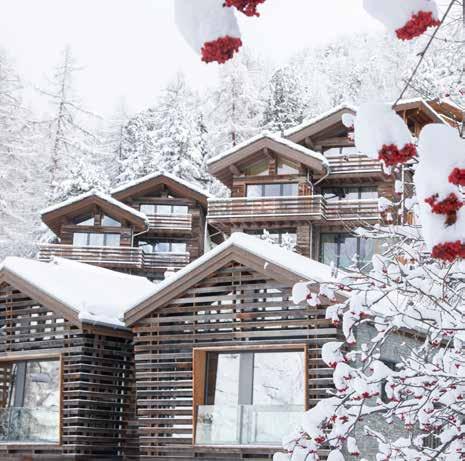

“The new Mountain Ashram—a fresh take on the classic Swiss spa—is a mystical indoor-outdoor space that draws on centuriesold wellness traditions.”
an herb-filled, stone-heated Bhutanese bath.
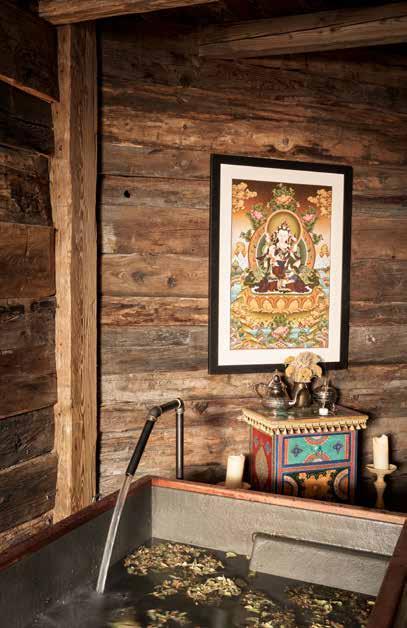
Guests are encouraged to contrast-bathe—flowing between a steam room, a 105-degree Japanese-inspired onsen with unobstructed Matterhorn views, and a 32-degree natural coldplunge pond. You can pop in for an après-ski soothing of sore muscles, or devote an entire day to self-care. Therapies range from Kobido, a Japanese massage technique that acts like a natural face lift, to a Tibetan-honey body treatment meant to increase blood circulation, calm the nervous system, and relax tight muscles. With a clear mind and rejuvenated body, forge onward to fully appreciate all Zermatt has to offer, on the slopes and off. Cervo’s new ethos, “beyond exploring,” is particularly fitting this winter. The much-anticipated Zermatt-Cervinia Alpine Crossing is due to launch in Spring 2023. The high-tech cable car will enable skiers to smoothly cross into Italy via a scenery-drenched, Matterhorn-heavy, four-minute journey.


SPA
SOCKS FOR UPLIFTING EXPERIENCES

DAHLGRENSOCKS.COM
of the SKI WORLD

Curating a vast collection of ski paraphernalia is a labor of love – as well as good business.
 by MICHAEL MASTARCIYAN
by MICHAEL MASTARCIYAN

HELI BOUTIQUE
In 1922, British archaeologist Howard Carter unearthed one of the most astonishing treasures the world had seen – the tomb of King Tut. As Carter peered into the dusty 3,000-year-old Egyptian burial chamber, his benefactor Lord Carnarvon anxiously asked the million-dollar question.
Do you see anything?
Yes, replied the awestruck Carter. Wonderful things!
This is rather what a visit to Vintage Ski World in Carbondale, Colorado feels like — a fantastical voyage through time and space where you can touch, see, and even purchase the wonderful things that span the sport’s golden ages.

Vintage Ski World’s owner and chief curator Richard Allen is something of a swashbuckling ski junkie. More Indiana Jones than Howard Carter, tales of his Rocky Mountain skiing exploits and treasure-hunting adventures date back to the 1950s.


“Over the years, I’ve amassed one of the largest collections of ski equipment and memorabilia in the world. This includes over a thousand pairs of skis and more than 10,000 pieces of vintage ski clothing, accessories, and works of art,” says Allen proudly.
Part brick-and-mortar boutique, part online shop, part museum, Vintage Ski World is a jaw-dropping storehouse of ski history. From 150-year-old handmade wooden Scandinavian skis, to Willy Bogner Senior’s outfit from
77
PHOTO COURTESY OF ALAMY
PHOTO COURTESY OF RICHARD ALLEN
PHOTO COURTESY OF RICHARD ALLEN
the 1936 Winter Olympics framed in a shadowbox direct from Germany’s Bogner Museum, to an original Aspen 1970s watercolor by acclaimed American painter Cecile Johnson –nearly anything and everything for the ski enthusiast can be found in this alpine Aladdin’s cave.
“We also have old snowshoes, vintage Snurfers, and shot skis for sale. In two lockers next door we have 10,000 pieces of vintage clothing with all the accessories including scarfs, hats, gloves, knicker socks, goggles, and sunglasses. We even have vintage 1970s Killy Bolle mirrored sunglasses and the bubble goggles made famous by James Bond in Her Majesty’s Secret Service,” says Allen.
Almost the entire collection of alpine clothing and equipment is for sale. On occasion, it’s also available for hire. Vintage Ski World has been Hollywood’s go-to ski rental shop for years.
“One of our biggest rental contracts was providing the film Hot Tub Time Machine with most of its wardrobe and equipment, which was such a fun collaboration. Another of my favorite rental projects was working with HBO’s Mad Men, for which we did two episodes. One was a scene where Don Draper’s ad agency had picked Howard Head as an account. We supplied them with two pairs of unmounted Head skis. The other was providing clothing and boots for an episode that involved a ski trip where the family had all the ski clothing and boots on the kitchen table getting ready to go to Aspen,” says Allen.
The shop’s eye-catching alpine artifacts also attract the attentions of big players in the fashion world, including mega-
brands like Ralph Lauren.
“We love to collaborate with companies like Polo Ralph Lauren, who regularly rent or purchase items for their ads or their window displays. For a while, every time Abercrombie opened a new store, they would purchase over 20 skis and snowshoes for display and props for that location,” says Allen.
After 47 years of collecting, Allen says managing Vintage Ski World is now his prime focus, leaving the treasure-hunting aspect to a group of elite pickers and antique dealers across the United States and Europe. Staying put also gives Allen time to reflect on what pushed him to make retail skiing his labor of love and life’s work.

“I have always been drawn to the old wood skis. The craftsmanship as well as the patina always got my attention. These old skis were handmade by master carpenters out of beautiful woods like hickory, pine, maple, and ash. My customers also seem to have a fond connection and memories of their old equipment. When they see equipment that they previously owned in our showroom museum, they light up and smile. We get to hear so many stories about people’s fond memories of skiing with their families and friends, and this provides me with a connection that is very special,” says Allen.
“Some folks come to find their favorite vintage ski patches, pins, and stickers from ski areas they enjoyed. Others are excited to find posters and photos of the past they thought were long gone, but now they can decorate their homes with images they remember with special meaning. Hey, you know what they say: One person’s trash is another person’s treasure,” Allen adds with a grin.
78
HELI BOUTIQUE
ASPEN
suitereyad.com | 970.429.9606 | aspen@suitereyad.com

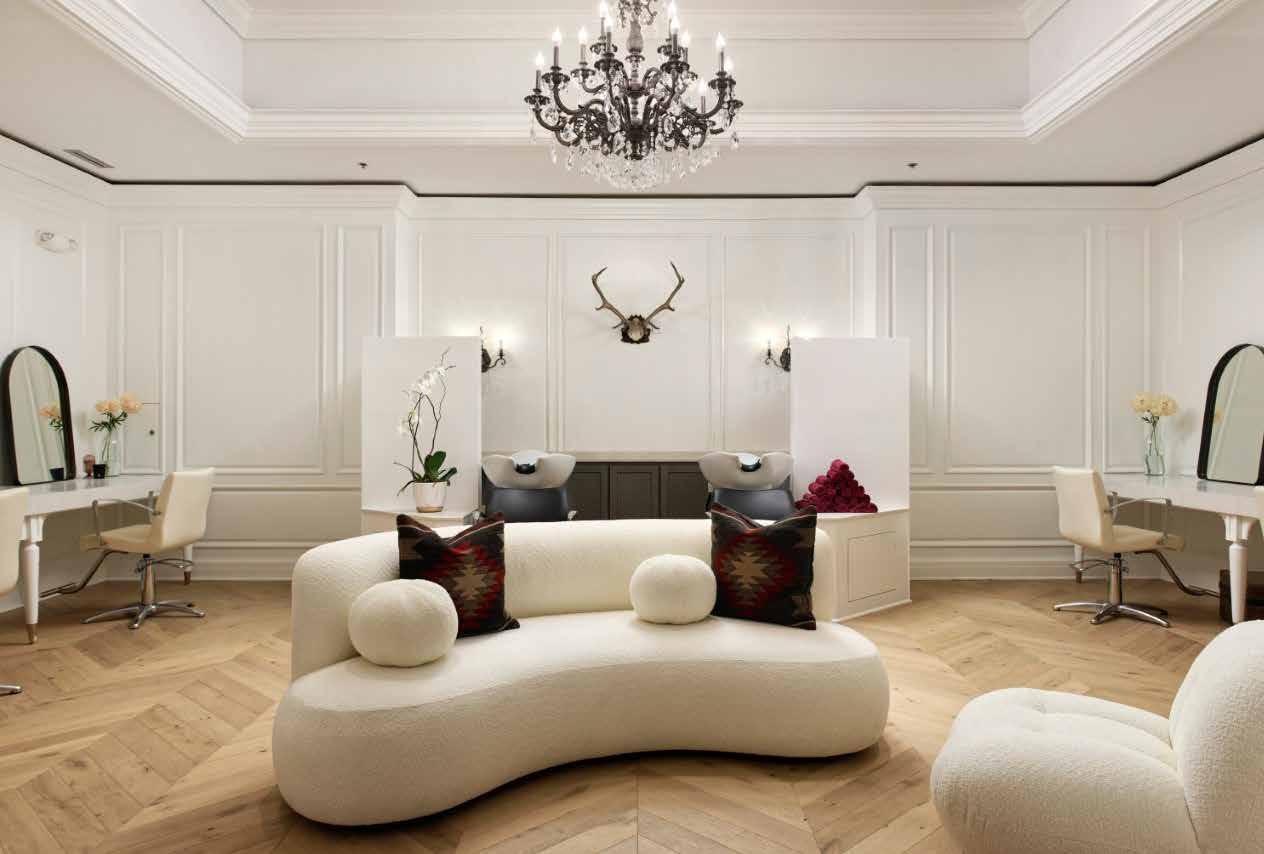
Fly South
When a beautiful Chilean woman began to talk about Pichelemu, a then-obscure Pacific Coast surf town, it would lead to one of those life-changing experiences for Reggie Crist. Quickly, the U.S. National Ski Team racer and his teammate sold their 203cm slalom skis, bought surfboards and, on the recommendation of their Chilean muse, made a motion for the ocean.
“We surfed the biggest waves of our lives,” Crist says, fondly reminiscing about the start of an enduring love affair with Chile, a country where he could pursue two of his great
by ANDREW FINDLAY
passions—surfing and skiing.
Back then Crist chased snow in the Northern Hemisphere during race season, then followed it to the Southern Hemisphere for off-season training at Portillo and Valle Nevado. And while his first visit to Pichelemu was a full-on dirt-bag adventure, fast-forward 30 years and Crist’s time in Chile is now firmly on the other end of the luxury scale.
Through his boutique company, Stellar Adventure Travel, his Southern Hemisphere winters are full of heliskiing and dropping big Andean lines with guests. If guests are keen,

In the deep powder of the Chilean Andes, summer is a whole different ball game.
HELI
PHOTOGRAPHY COURTESY OF REGGIE CRIST

occasionally they’ll zip out to the coast for a surf session or beachside seafood extravaganza.
“Where else in the world do you have skiing on 20,000-foot mountains within 200 miles of the coast?” Crist says.

Before pioneering his adventure travel company, Crist was a pioneering athlete. His parents first put skis on Crist when he was two years old, learning to snowplow on the rope-tow bunny hill at Homewood, just south of Tahoe Pines on Lake Tahoe. Later, time spent carving the groomers as a kid in Sun Valley led toward bashing gates and ski racing. Eventually he made the National Team, racing World Cup events in the 1991-92 and 1994-95 seasons, and placing 28th in Downhill at the 1992 Winter Olympics in Albertville. Post-World Cup, he and brother Zach dove into bigmountain skiing, performing in front of the lens for production companies including Warren Miller, Rage Films, and Teton Gravity Research. He also helped pioneer a new ski discipline, the sport of Ski Cross, taking gold at the X Games in 2002 and 2006— the first X Games competitor to win gold twice. His experience in film work prompted Crist to launch Stellar Adventure Media to provide production support for athletes skiing mountains across the globe. At the same time, Crist started a sister company, Stellar Adventure Travel. When his wife Laura delivered their first child in 2008, his appetite for tackling big lines and spicy spines for the camera began to wane. Nowadays, Crist juggles family life, with a trio of kids aged six, 10 and 14 years, while guiding, skiing with

“The Andes can be fickle, but they have the elevation so you can always find good snow.”
clients, and curating trips to some of his favorite mountains, including the steeps of Haines, Alaska, the deeps of Hokkaido and, of course the Chilean Andes, his favorite mountain range on the planet.

The Andes span the South American continent for 5,500 miles, are more than 200 miles wide in places, and reach their pinnacle at Aconcagua, which soars to 22,838 feet. Crist’s Andean adventures are focused mostly on a radius of peaks east of Santiago and within a 45-minute heliflight from the Pacific Ocean.
“The Andes can be fickle, but they have the elevation so you can always find good snow,” he says. “We’re usually landing at 13,000 feet or higher.”
Helicopters help. Even last season, when it hadn’t snowed for weeks, Crist and his team were able to mine north-facing couloirs and bowls for light, dry powder.
Crist credits having Chilean connections that go back decades for helping him to continually refine the experience. For the past decade, Stellar had based its trips out of a Valle Nevado hotel. It was fine, Crist says, but he felt there was something missing. A few years ago, he learned about Refugio Uno Farrellones, a luxury house-slashboutique refuge, situated within easy striking distance of resort skiing at La Parva, El Colorado, and Valle Nevado. It’s also an ideal spot to stage helicopters—the fit was perfect.
“It’s an older house and a bit rustic but we bring in our own chef and DJs,” Crist says. “It’s not like ordering off the menu at Valle Nevado. It elevates the experience.”
In-bound guests even have the option for a pickup at the W Hotel’s rooftop helipad in Santiago for a shuttle to Refugio Uno. Details like this are important to Crist and, at 54, he’s still as excited about skiing as he was when shredding with buddies at Sun Valley or battling for a spot on the National Team.

“My parents instilled a sense of following your passion and, that if you do it long enough, you’ll become an expert,” Crist says. “After my time on the U.S. Ski Team most of my teammates left to get real jobs. I didn’t. I wasn’t done.”
With an appetite for adventure like Crist, you could never truly be done with skiing. In fact, it’s hard to imagine him doing anything else.
83


SNOW STYLE SHOP SNOWSTYLESHOP.COM
PHOTO COURTESY OF HUNTER HART


SNOWSTORIES LIZA Onesie FRAUENSCHUH Necklace UNOS DE 50 Bracelet UNOS DE 50 Goggles VUARNET MICAH Pants RH+

LIZA Onsie ONE MORE Gloves GOLDBERGH Boots INUIKII Hat MY SOMBRERO YANA Fanny Pack GOLDBERGH Goggles GOLDBERGH Dress MARIO STUDIO Hat MY SOMBRERO NESTOR Pants ONE MORE Hat HEAD SPORTSWEAR Gloves ROSSIGNOL Turtleneck RH+ Boots INUIKII clockwise from left MICAH Pants DESCENTE Turtleneck DESCENTE Gloves DESCENTE Boots INUIKII Hat MY SOMBRERO LUCIA Ski Bibs GOLDBERGH Ski Turtleneck HEAD SPORTSWEAR Goggles YNIQ Boots GOLDBERGH DAVID Pants TONI SAILER Goggles TONI SAILER Goggles YNIQ Boots INUIKII PHOTOGRAPHER: ANTONIO CORDERO STYLIST: CAROL GAMARRA HAIR & MAKEUP: NOELIA FUENTES PHOTO ASSISTANT & VIDEO: RAFAEL FUENZALIDA ASSISTANT STYLIST: REBECCA WILSON Thank you to: Doreen and William - Cortijo de las Piletas, Antequera, Spain. Restaurante Plaza de Toros Antequera, Spain. And our Matador Francisco Calvente Cintado
TOTORO!RO!

 YANA Onesie JET SET Boots INUIKII HAT MAESTRA NATI DAVID Traje de Luces CARMEN MOTA
YANA Onesie JET SET Boots INUIKII HAT MAESTRA NATI DAVID Traje de Luces CARMEN MOTA
Baselayer Top NEWLAND FROM ITALY
Baselayer Pants NEWLAND FROM ITALY
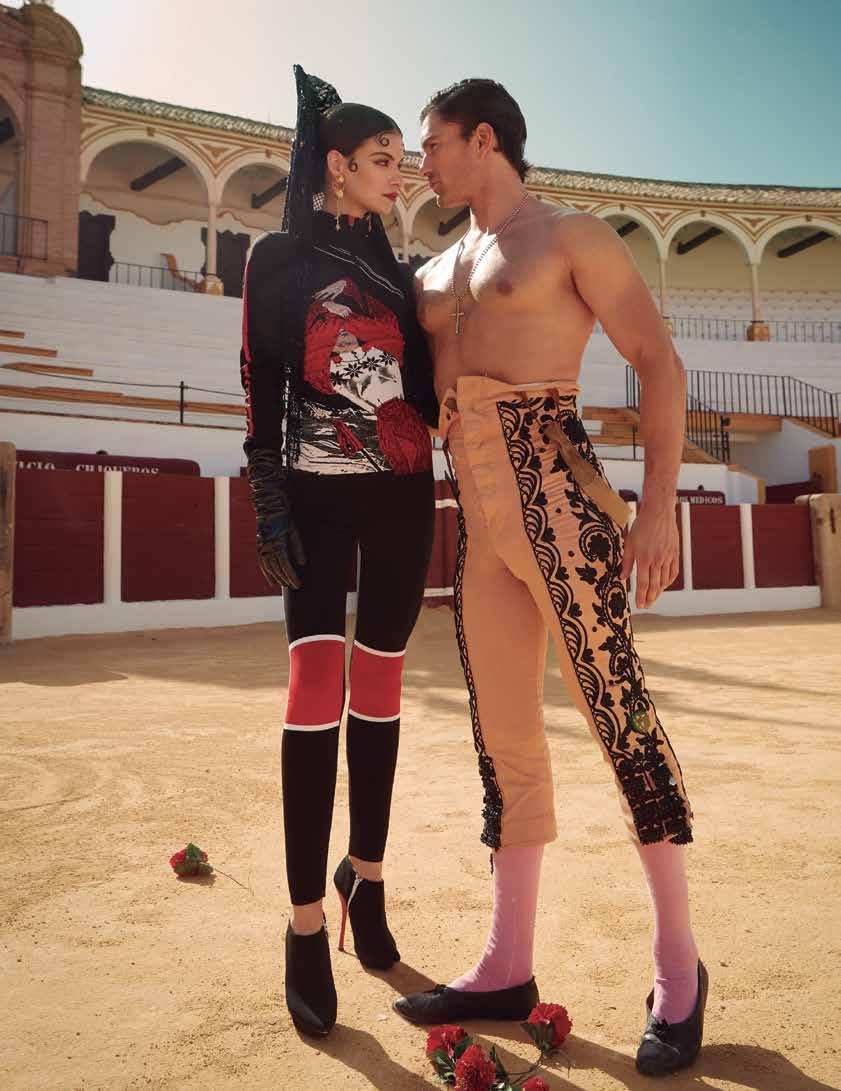 LUCIA
DAVID
Traje de Luces CARMEN MOTA
LUCIA
DAVID
Traje de Luces CARMEN MOTA

LIZA Jacket ROSSIGNOL Goggles YNIQ Necklace UNOS DE 50

YANA Jacket RH+ Boots INUIKII LIZA Jacket GOLDBERGH Boots INUIKII

LUCIA Ski Bibs POSTCARD Boots GOLDBERGH Scarf GOLDBERGH YANA Ski Bibs GOLDBERGH Boots INUIKII

MICAH
Jacket SPORTALM
Pants SPORTALM
Sunglasses VUARNET
Boots INUIKII
NESTOR
Racesuit HEAD SPORTSWEAR

Jacket HEAD SPORTSWEAR
Sunglasses OAKLEY Boots INUIKII
 LUCIA Scarf NOBIS Pants BOGNER Sweater FRAUENSCHUH Boots INUIKII
LUCIA Scarf NOBIS Pants BOGNER Sweater FRAUENSCHUH Boots INUIKII

DAVID Scarf ELEVENTY Pants ELEVENTY Sweater ELEVENTY Boots ELEVENTY Socks ELEVENTY Goggles YNIQ Skis BOMBER

NESTOR Jacket BOMBER X BIONIC Pants BOMBER X BIONIC Sunglasses BOMBER X BIONIC Goggles VUARNET Beanie WE NORWEGIANS YANA Onesie PERFECT MOMENT Boots INUIKII Skis BOMBER Hat MY SOMBRERO
 PHOTO BY JACE ROMICK PHOTOGRAPHY
PHOTO BY JACE ROMICK PHOTOGRAPHY
Touching theEdge
by LESLIE ANTHONY photography by MATTIAS FREDRIKSSON
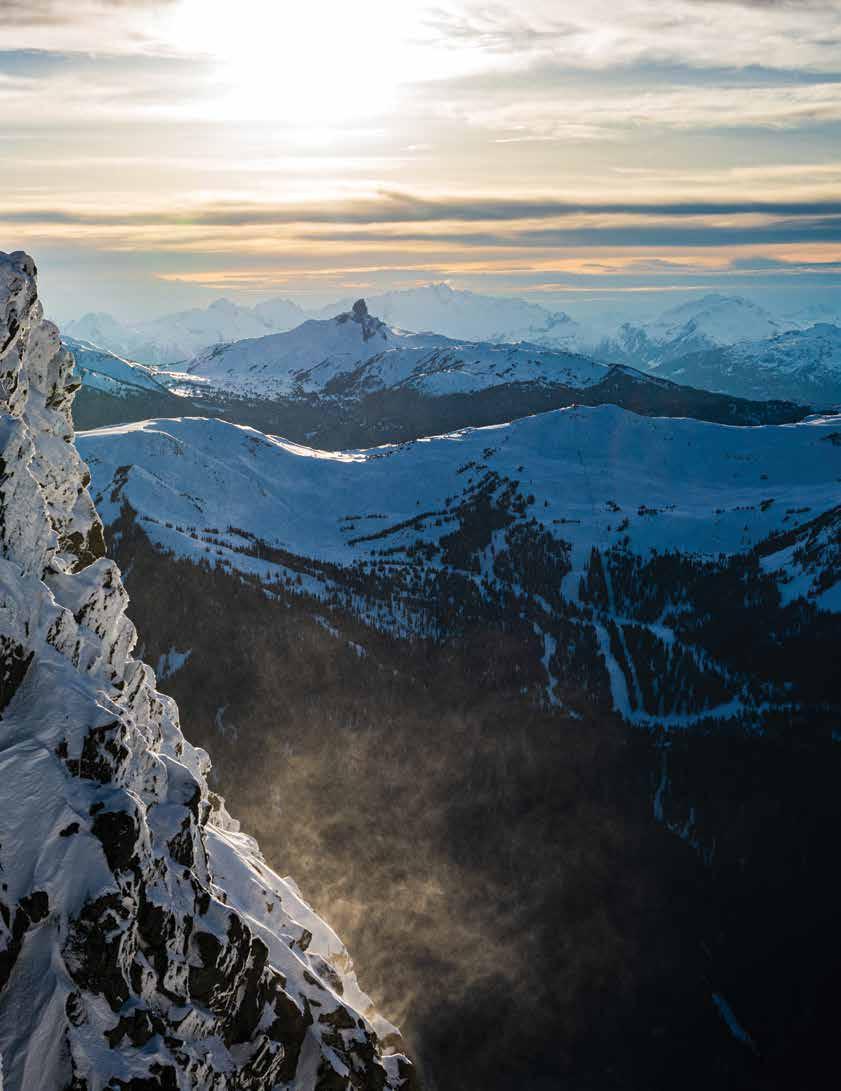
FOR VISITORS TO WHISTLER BLACKCOMB, NORTH AMERICA’S LARGEST RESORT COMES WITH ONE VERY BIG BONUS. ROOM TO EXPLORE.
Ski areas might be the only place in the world where explosions are an acceptable alarm clock. Indeed, the percussive reverberations of avalanche-control bombs draw skiers up from the valley like a siren call to the peaks. With its vast alpine acreage to manage, British Columbia’s Whistler Blackcomb may offer a more relentless alarm than most on a snow day, but it only reflects the greater rewards of heeding its call.
One day last winter I’d answered that summons, heading out in the dark to join a growing lift-line for the first ride up. With snow falling at two inches an hour and over one foot on the ground already, snow was plentiful and the skiing great. With a continuing rumble of muted blasts signaling that the alpine wouldn’t open for a while, I poked around in the mid-mountain whiteout, looking for something I didn’t yet know but was sure I would find. And then, after

a few zigs and zags through the trees, I popped out alone onto a sharp ridge and there it was — an open, drifted-in shot hemmed by snow ghosts that dropped from the storm-swept spine into a welcoming glade of old-growth forest. At that point, I didn’t know precisely where I was; but how I could live and ski in a place for 20 years and never see this line? This was going to be good.
And it was good. A hundred turns of fat, light flakes
100
streaming up over my shoulders. At the bottom, mesmerized by my discovery, questions crowded my brain. Could I actually have been here before but perhaps it looked — as much of the resort does through its annual inundation with 40 feet of snow — completely different? Or maybe it was just the vertigoinducing whiteout of another massive Pacific storm that had rendered it unfamiliar.
While I wasn’t worried about finding my way back to a
lift — all in-bounds ridges and bowls at Whistler Blackcomb funnel back to humanity-gathering cat-roads — what I did want to figure out was how I might return to this very spot; if no one else bumbled upon it before I returned, I could sign my name to another knee-deep run. And I knew that in a storm like this, in a place this big, there was a good chance no one else would find it.
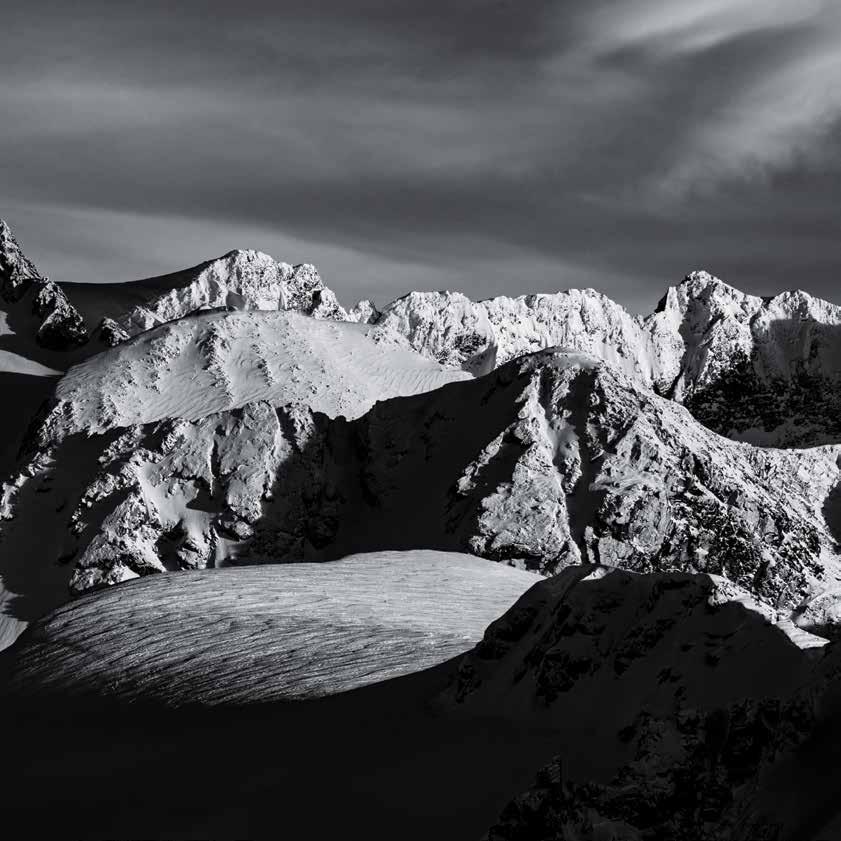
101
SIZE MATTERS
For adventurous North American skiers, Whistler Blackcomb proves one thing their European counterparts already know: size matters. More than any other single reason, this is why the perennially top-rated resort racks up more than two million skier-visits annually. It’s also why I live here: room to lose myself, every day, without being lost at all. While either of the resort’s two mountains can deliver on this promise alone, together they offer a vacation’s, a season’s, even a lifetime’s worth of options and adventure. As Captain Kirk famously opined in the opening sequence of the original Star Trek television series: “Space — the final frontier.”
Granted, size isn’t the only consideration. On a vertical landscape, space also delivers diversity, opportunity, and, as I found out that day, surprise. Like many Whistler denizens I was first enticed to this colossus of the Coast Mountains by the cumulative seduction of photos, movies, magazine stories, and lift-line conversations. And when I finally did visit, the facts on the ground spoke for themselves: two enormous mountains, 37 lifts, a dozen on-mountain restaurants, 13 alpine bowls, three glaciers, 5,280 feet of vertical, and over 8,171 acres of ridges, trees, bumps, steeps, chutes, cruisers, and anything else you could think of to fill a curious snowslider’s soul. Not to mention the always-open boundaries — a world of ski-touring amidst blue-toothed glaciers and untouched alpine. There was also the draw of wilderness, so oceanic as to render the resort an island within. Riding the lifts here I’ve watched mama bears just out of hibernation standing erect with a nose to the wind, newborn cubs rolling playfully at their feet. I’ve seen mountain lions and bobcats trot across the pistes, and bald eagles soar in from the Pacific for a look-round. From the

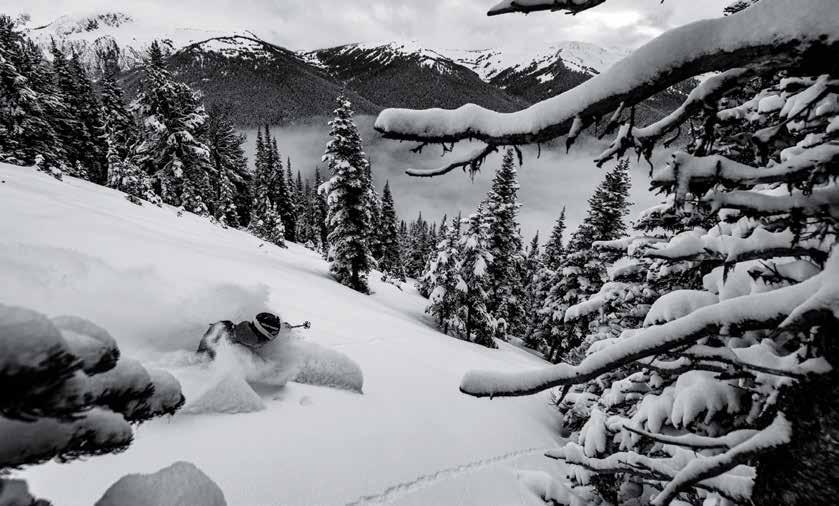
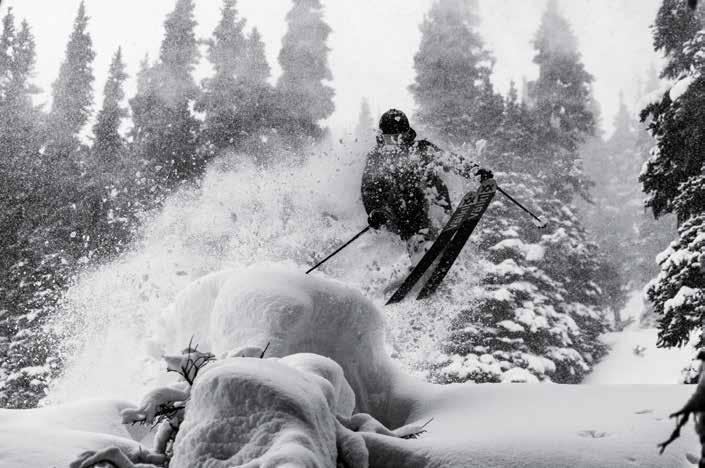
103


summits of these peaks, where Whistler Village is reduced to the size of a thumbnail, it can seem as if it weren’t there at all.
For overseas visitors attuned to the call of the wild, that fact alone is a potent draw — and the reason the village presents as a bustling Tower of Babel awash in the lilts, twangs, and gutturals of a dozen languages. This same ethnic vibrancy is behind a multicultural heritage that makes Whistler the most international and cosmopolitan of any North American resort — another point of appeal that’s reflected, among other ways, in the culinary diversity of over 200 dining and drinking establishments, many of them cutting edge and tops in their class, whether they be purveyors of regional-signature Pacific Northwest fusion, landed-immigrant sushi 2.0, or globally celebrated microbrews. Couple this with the numerous other distractions of winter play — heli- and cat-skiing, crosscountry skiing, snowshoeing, skating, ice-climbing, zip-lining, dog-sledding, bungy-jumping, tubing, and even bobsledding on an Olympic course — then add the significant cultural offerings like the Audain Art Museum, the Squamish Lil’wat Cultural Centre, a daily festival’s worth of live music, and a surfeit of film, photography, arts, and snowsports events that culminate every spring (at least pre-covid) in the legendary World Ski & Snowboard Festival, and you have the stimulus and variety of a big-city metropolis condensed into a smalltown package.
Although it remains a town of but 12,000 souls, it’s also a community whose vibrant mix of art, culture and outdoor enthusiasm has always welcomed and embraced tourism. In cultivating a life apart from the snowsports industry that keeps the town afloat, however, it has also created something more meaningful to share with visitors — character. And if you scan the five terrain parks, tube park, skatepark, pool complex, and pump track, you’ll see that there’s no age-limit on participation. Young or old, living here or visiting, one thing was clear to me from the start: in Whistler, exploring was just what you did. Whether physically or culturally, you went to the edge — and stayed there.
That edge is obvious in the town’s many history-making residents: the balls-to-the-wall style pioneered by the “Crazy Canucks” on the Dave Murray Downhill course, leading to a hometown World Cup win by Rob Boyd in 1989; the groundbreaking first descents in the Coast Range by Eric Pehota and Trevor Petersen in the early 1990s; the work of filmmaker Greg Stump over the decade he lived here; ski-photo titans like Paul Morrison, Eric Berger, and Blake Jorgenson; the invention of the twin-tip ski and subsequent park-and-pipe revolution sparked during the Horstman Glacier’s summer freeride camps by Mike Douglas and the New Canadian Airforce; a long list of big-mountain freeride heroes who’ve won the World Freeride Tour or become film staples; ditto the ranks of Olympian and FIS World Cup skicross medalists like Aleisha Cline, Ashleigh McIvor, Marielle Thompson, and Kelsey Serwa; the slopestyle heavyweights that start with Sarah Burke and end in a litany too long to print. And though I’m not as well versed in it, the snowboard ledger here may be even heavier.

105
HISTORY MATTERS
None of this could have been predicted in 1914 when, after a lengthy boat and rail trip from Vancouver, Alex and Myrtle Philip arrived in the valley to open a fishing operation. Their upstart Rainbow Lodge would flourish for decades and turn the town of Alta Lake (Whistler’s original name) into a summer tourist destination. Skiing the largely inaccessible mountains was but a glint in the eye of a select few adventurers until 1960, when the Garibaldi Lift Company formed with the intention of building a ski area to bid on the 1964 Winter Olympics. Although its bid was ultimately unsuccessful, Garibaldi’s new ski hill, Whistler — named for the piercing calls of the alpine hoary marmot — opened in 1966. Despite a perilous, slide-prone dirt road that took five hours to drive from Vancouver (now reduced by a modern highway to a smooth 90 minutes), Whistler soon became a hit. With the newly minted Resort Municipality of Whistler coordinating development, phase one of today’s main village was completed in time for the opening of neighboring Blackcomb Mountain in 1980. The two mountains were originally separate enterprises, but in 1986, Vancouverbased resort-development company Intrawest purchased Blackcomb, then added Whistler a decade later to create the slick, dual-mountain behemoth that today flies under the banner of Vail Resorts. When the five-ring circus of the Winter Olympic Games finally did hit town in 2010, these twin peaks added a full-circle Olympic story and several high-profile legacies that have only expanded the town’s function and appeal.
During my own two decades here, Whistler’s transformation has included the addition of a small country’s worth of accommodation and real estate, and much upgrading and expansion of terrain and ski operations, including the world-renowned Peak 2 Peak Gondola, a 2.73-mile engineering marvel linking the two mountains at a maximum height of 1,427 feet above the Fitzsimmons Valley — akin to taking a helicopter ride while still attached to the ground.
Of course, gewgaws like this are the kind of thing ski magazines point to while annually singing Whistler’s praises. Like these words from a 1996 resort guide: “Given the hyperbolic publicity it receives, there’s a danger Whistler Blackcomb could become the most overrated ski resort on the planet. The truth, however, is that the size of these mountains, the access to glaciers and high alpine, the sheer scope and diversity of terrain, and the spectacular setting, combine to make it an untouchable experience.”
Like many glowing reports rendered by ski writers who need to make a buck, I wasn’t entirely convinced when I wrote it — though after only a few visits I acquired some surety. Today, as a local, I look back on those words as understatement: even the hype didn’t live up to the reality.

106
“The worldrenowned Peak 2 Peak Gondola, akin to taking a helicopter ride while still attached to the ground.”


SNOW MATTERS
Of course, it all starts with snow. Packing moisture from Hawaii and Arctic air from the Gulf of Alaska, winter storms cycle in from the North Pacific to engulf Whistler Blackcomb. Brooding and powerful, they are tempests girded for battle — fighting to find a way up, over and through the labyrinthine Coast Mountains. Frustrated at the rocky barrier, the clouds release a tantrum of snow at the first opportunity. Only 25 miles from the coast, snowfall is frequent enough in Whistler that most visitors who spend more than a couple of days discover why a powder day here, with its elbowroom and
diversity of terrain, is an experience within an experience.
Sure, like any big ski area there’s a ton of powderhounds and huge competition for the goods, but employing a common-sense strategy goes a long way toward maximizing your enjoyment on a powder day, and it wouldn’t be right of me not to offer a few insider tips. First, get to the lifts early. Even if you can still hear bombs going off and the alpine won’t be opening for a while, the lower- and mid-mountains — featuring an amount of terrain equivalent to several regular-sized ski areas — are always good to go. If it’s still

snowing, your first move while you’re uploading should be to check the wind direction, because areas in the lee of the wind will always be 30-50 percent deeper. Next, look at the grooming report; there’s no better way to warm up — and few as outright fun — as 3,000-vertical-feet of groomer covered in fresh snow. The comfort of a predictable base allows you to establish your snow-slashing rhythm, and there will always be enough of the resort’s 200-some runs open to keep you occupied until the alpine lifts start cranking.

As for the eternal question of Which mountain?, there’s an argument to be made for starting your day on Blackcomb: more mid-mountain options, generally fewer people, and an alpine that tends to open far ahead of Whistler’s. In part, the latter is due to geology: Whistler’s terrain is more complex, with trickier pockets, cornices, and bowls that require more bombing to open safely; Whistler is also larger in acreage — with a greater share of treeless alpine. But this operational wrinkle can be a bonus: skiers can enjoy all that Blackcomb has to offer and then, when the Whistler alpine opens, move over to fresh horizons via the Peak 2 Peak Gondola, which represents not only an acme of lift engineering, but possibly the most brilliant powder-day convenience known to mankind — next to an avi-bomb alarm clock.
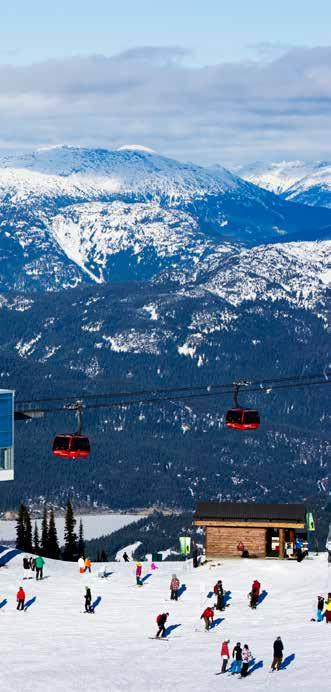
109
Fiercely Feminine
Meet the women who are the driving forces behind four of winter fashion’s most trendsetting designs.
 by MICHAEL MASTARCIYAN
by MICHAEL MASTARCIYAN
You may have seen their creations on the glitzy slopes of Kitzbühel, Cortina d’Ampezzo, or Megève. Perhaps you’ve purchased them in the chic boutiques of Aspen, Crans Montana, or Chamonix. But what you see in the shop window
or on the hanger is only part of the story. We spotlight four of the ski world’s most cutting-edge fashion houses—Goldbergh, Houdini, Authier 1910, and Fleischer Couture—and talk to the women behind these successes.
AUTHIER 1910
THE PERFECT PERSPECTIVE
Perspective is everything for the creative engine behind Authier 1910— one of the boldest, hippest luxury skiwear labels on the market today.
“I’m dressing people with ski clothing every day. I know what they like and don’t like, and that gives me a unique perspective on what we should be making,” says Lee Keating, design czar at Authier since 2010. Keating is also part owner of Performance Sport, one of Aspen’s most upscale ski boutiques. Part stylist, part designer, part business owner, Keating is a fashion-world triple threat, and she’s less than shy when asked what sets Authier apart.

“An Authier piece is perfect. We use the highest quality materials, it’s a perfect fit, it’s functional in terms of an active, athletic garment,” says Keating. She readily admits the hunt for perfection is her primary goal when creating skiwear.
“We’ve spent the last 11 years trying to make the perfect jacket, and the perfect pants, and the perfect layering piece. We don’t try to reinvent the wheel every season but we continue to work and perfect the perfect pieces—all from feedback from our clients. It’s 100 percent a product driven by the end user,” Keating says.

111
GOLDBERGH
WHO’S AFRAID OF SEXY?
One of the ski world’s most fiercely feminine brands, Goldbergh is not afraid to be sexy when it comes to designing clothing for women who want to shred in style.

“Our collection offers women all the freedom of movement they need to be confident in their sport, whether they’re conquering challenges on the slopes or pushing their limits in the gym. Goldbergh brings luxury and fun together in perfectly designed skiwear,” says Lieke van den Berg, who founded the luxury ski and lifestyle brand with business partner Sandra Peet in 2009.
“Being born into a family that considers skiing the greatest sport on earth, I have shared this opinion since I first stood on skis at the age of four. The motivation for creating Goldbergh is a passion for the sport and the desire to make women look more beautiful and confident in their skiwear,” says Peet,

whose family has been in the retail skiwear business since 1976. Loud and proud about her ski-junkie roots and her passion for fashion, van den Berg’s ultra-feminine, body-hugging silhouettes are ultimately the byproduct of a frustrated skiwear shopper who had to create for herself what she couldn’t find in the marketplace.
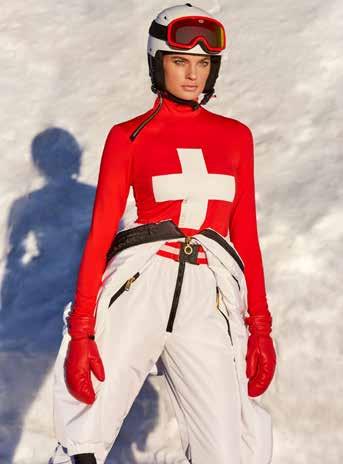
“Skiing and fashion have always been my two biggest passions, so I decided to make my passion for fashion my profession. When I started out, skiwear was big and oversized, and the baggy “snowboard look” was hot and happening. Being a female skier, I preferred the so-called Rennhose look—tight ski pants with a very race-inspired silhouette, but for ladies they were impossible to find. I thought if I am looking for this, there must be more women who would like to look feminine and sparkly when hitting the slopes,” says van den Berg.

113
HOUDINI
PUSHING BOUNDARIES WITH GUILT-FREE CHIC
In 2001, when Swedish fashion-industry juggernaut Eva Karlsson and business partner Hanna Lindblad took over the reins of Houdini, one of the most stylish, eco-friendly, and sustainable mountainwear brands, their goal was not to sell more product. It was to sell less.




“We don’t need more clothes, but we need clothes that can do more,” has been one of Houdini’s guiding principles, something Karlsson stands firmly by today.
“We don’t design seasonal themes. Anything seasonal will be dated after that season, which in turn will increase overconsumption. On the contrary, we design clothes that can be worn for a very long time without going out of fashion,”
says Karlsson. “That’s a hard thing to do, but the right thing for the planet. The same thing goes for color. Any new color must match the previous season’s colors, so you can combine the new piece with an older piece from Houdini.”
Karlsson’s “do the right thing” philosophy sets them apart from many competitors—but the true magic behind Houdini’s success is its ability to push the boundaries of style and sustainability by conjuring genuine, guilt-free chic. From crisp, minimalist ski jackets, to the company’s innovative and award-winning initiative Project Mono Air—the world’s first fleece jacket designed to fight plastic waste—Houdini is the real deal.
FLEISCHER COUTURE
A SKI JACKET OF HER OWN

Norwegian designer Maja Mejlænder Fleischer may not realize it, but in some ways she’s the Virginia Woolf of skiwear, an accidental businesswoman who founded an outerwear company simply because she wanted to encourage women to get outdoors in warmth and style. “Our initial motivation was to inspire more girls to get out into nature by designing nicer skiwear. By combining fashion and sport we wanted to create products every woman feels good in despite cold weather. I’ve always had a passion for skiing, being out in nature, and for fashion,” says Fleischer. “So when I couldn’t find the perfect ski jacket, I wanted to make it myself. Fleischer Couture was born out of a desire to create a ski jacket for women that was both functional and fashionable, and in the early 2000s, this was hard to come by.” Since those early days, Fleischer Couture’s collection has grown from an assortment of numbered pieces to an array of elegant ski jackets, long and medium length coats, insulators, and a spectacular body hugging down skirt that is an absolute must-have.



HEART LAND
La vida buena in Central Chile.
 by ANDREW FINDLAY | photography by KARI MEDIG
by ANDREW FINDLAY | photography by KARI MEDIG
 Ski guide Guido Schilling skis the slopes of Volcán MochoChoshuenco in Chile's Lakes and Volcanoes District.
Ski guide Guido Schilling skis the slopes of Volcán MochoChoshuenco in Chile's Lakes and Volcanoes District.
When Portuguese explorer Ferdinand Magellan hit landfall near the tip of South America in 1520, he encountered giants – or so he thought. He called them Patagones, derived from the word for “paw” in his native Portuguese. Perhaps it was the effect of scurvy or too much time at sea, but some accounts had them reaching heights of 14 feet. These early explorers did get at least one thing right: the land that would become known as Patagonia is a place where hyperbole and the imagination run wild.
“Patagonia has come to say ‘hi’ today,” Guido Schilling, our guide, shouts cheerfully into a freight train of a wind threatening to strip us from the slopes of a volcano. In northern Patagonia, Volcán Casa Blanca is one of dozens of volcanoes in the seismically restless Lakes and Volcanoes region, 600 miles south of Chile’s capital Santiago. Some, like Casa Blanca, are extinct. Others, like Volcán Osorno, are dormant, puffing steam from fumaroles and slumbering until their next violent reawakening.
A half hour ago, we had scrambled to gear up in the base lodge of Antillanca, a club-owned ski resort with 3,000 members. Inside the lodge, junior racers from Chile and Argentina, here for the Patagonian championships, were crushing a buffet of chicken and rice. Outside, skies were calm as we rode up the antiquated double chair. But things changed as soon as we skinned up a ridgeline beyond the summit T-bar. A dense mist had cleared but a tempest suddenly snarled up from the south – a storm that would have billowed the sails of Magellan’s flagship, Concepcion.
“It must be more than 120kmh,” Guido yells out, his internal anemometer precisely gauging the wind speed.
Surrendering to the absurdity of the outing, I stop moving and lean as far as I can into the wind without falling over, convinced that I’m tilted at a 30-degree angle.
Born in Switzerland, Guido traveled to this region with a backpack almost 30 years ago, fell in love with the landscape, then fell in love with a woman. It’s easy to understand why he stayed—the natural order of things, I suppose—especially for someone from the cloistered and tidy world of Switzerland. There’s something wild and alluring here—the crystalline rivers, the hot springs, the endangered Araucaria Araucana monkey puzzle tree so sacred to the indigenous Mapuche people, the asados of meat large enough to induce cardiac arrest simply through the act of reading the menu, and towering volcanoes that are magnets for snow despite the molten heat that bubbles within.
Of course planting a seed is not enough to grow ski culture—it needs to be watered and nurtured. Guido and our local fixer Cristian Levy, the gregarious owner of Amity Tours, told us there was someone we had to meet, someone who understood the magic of winter in a land of volcanoes. In this regard, Tio Pepe is “a legend,” Cristian assures us. We find the 77-year-old further north at his home in Malalcahuello, rummaging around in a workshop full of old skis and poles. He wears the fur hat of a Cossack and his face crinkles warmly when he smiles to offer a strong hand to shake.
Following introductions, we head to Endemiko, a restaurant with a cool, modern feel that seems a tad ahead of its time in this rustic mountain community. Jose Herrera, who co-owns the eatery and adjoining boutique hotel with his dad, spent a few seasons in Whistler before returning to Chile to get serious and start a hospitality business in his hometown.
We sit down to a Chilean feast of melt-in-your mouth beef tenderloin, a bottle of Carménère (a varietal of French origin that Chile rescued from obscurity and now proudly claims as its own) and enough stories to fill a bible of skiing. Tio Pepe arrived in this village at age 35, fresh from military service. He had wisely opted for the mountain military unit and, for
118

119
Volcán Tolhuaca overlooking farmland in the Chilean Lakes & Volcanoes District.
clockwiselefttoright
1. A Chilean flag blows during a snowstorm at the mid-station café on Antillanca ski resort.
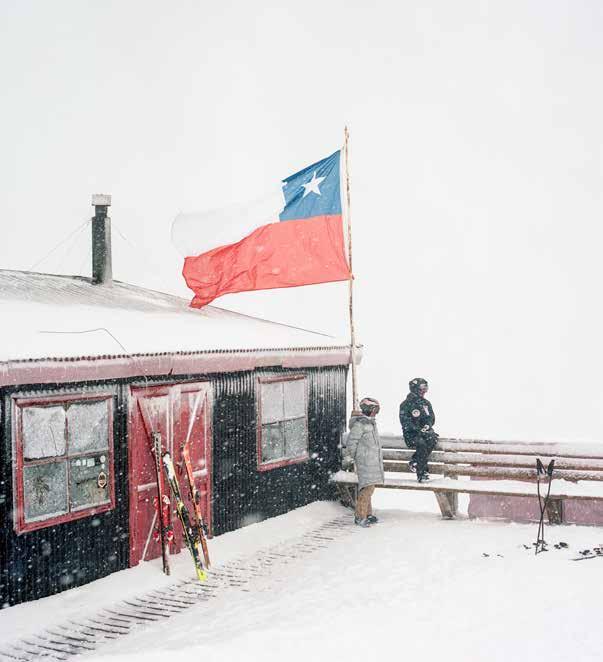
2. The cafeteria decorated for Chilean independence day at the Volcán Osorno Centro de Ski y Montaña.
3. Andreas del Real at the Volcán Osorno Centro de Ski y Montaña.
4. Lomo Liso con Papas Confitadas at Endémiko, Malalcahuello.
5. Legendary skier José “Tio Pepe” Córdova.
Tio Pepe, it sounded like an adventure camp for young adults, learning to ski and climb in the mountains around Portillo. Though snow piled deep around Malalcahuello, to his surprise most locals viewed winter—and snow—as a necessary burden, like paying taxes. It was a sacrilege to him. So, he decided to do something about it and show kids the joy of sliding across snow. Sounds simple enough, but it wasn’t.
“There was so much potential here for skiing with Lonquimay,” he says, referring to the nearby, perfectly symmetrical volcano. “I had to change the mentality of the people, but it took a while.”
Tio Pepe scrounged together ski gear and eventually coaxed students to hike up a rough road, skis and gear on their backs, to ski on Lonquimay. They would sleep in snow caves and cook with camp stoves for a few days at a time. It was character-building, to say the least, and it made an impact.
“The parents thought I was crazy,” he says with a shrug, adding that some of those students, now in their 40s, still come back to visit him.
It was the tenacious Tio Pepe who urged local government
officials to fund a Poma lift on Lonquimay back in 2000. Private interests stepped in soon after, adding modern lifts and the luxury Corralco Valley Hotel and Spa set in a forest of monkey puzzle trees a few minutes’ drive from the day lodge.

Following an evening full of local ski lore, we drive up the gravel road to Corralco, the closest thing to a destination ski resort in the Lakes and Volcanoes region. I imagine Tio Pepe and his youthful charges making the same journey, decades ago, on foot. We head to the hotel for double espressos, giving the spring sun time to soften the snow for our ascent of Lonquimay. A family of astonishingly attractive Brazilians lounges nearby in their Cordova ski attire, the teenagers glued to their Smart phones and looking as though actual skiing is a remote possibility.
Not for us—skiing is paramount. James Ackerson, the funloving general manager of Corralco, is happy to meet us at the day lodge. This American ski-industry vet spent two decades chasing the endless winter. He started his journey teaching skiing at Sugarbush before working his way up to VP of Skiing at Heavenly Valley.
120




clockwiselefttoright
1. Ski guide Guido Schilling skis the slopes of Volcán Mocho-Choshuenco in Chile's Lake and Volcanoes District.

2. The villa wing of Hotel AWA on the shore of Lake Llanquihue near Puerto Varas.
3. A room at Hotel AWA on the shore of Lake Llanquihue near Puerto Varas.
“Corralco is a ski resort in its genesis,” he tells us. “After years of taking other people’s positions, it’s great to be here from the ground up.”
While riding the Coloradito Quad, we spot Tio Pepe arcing artful stem christies on the fresh groomers, sporting his trademark Cossack hat. Two lift rides later, we’re slapping skins on the skis. A 35-degree planar slope angles toward Lonquimay’s classic catered summit. A half dozen other adventure skiers are ahead of us, capitalizing on a bluebird day to tag the summit. I’m feeling the foggy effects of a few too many glasses of Carménère. It’s time to get the chores done.
Lonquimay rises to 9,400 feet near the northern border of the Geoparque Kütralkura. (Elevation, of course, is a fluid concept when it comes to volcanoes.) Geopark status is a UNESCO designation that, while inferring no special protection, celebrates unique geology. This area of Chile is one of the most volcanically active places in the world, one where indigenous culture is in large part defined by their relationship with volcanoes. The most powerful deity of the Mapuche, Pillan, is the god of thunder and fire. He watches over the wellbeing of the people but, at times, is prone to a ferocious temperament.
It's a disconcerting thought, as we switchback up a mountain that could rumble to life at any moment. Even more troubling is the map of the Geoparque that I had the misfortune of looking at last night. It highlights,


“Around here, anything seems possible.”
in blood red, the areas of alto peligro (high danger). Lonquimay is one of those places. But today, the giant seems docile.

Soon we are basking on the summit, naming volcanoes that pierce the skyline around us—including Volcán Mocho, our next skiing objective. Together we drop into Lonquimay’s sweeping south face, on corn snow as tender as last night’s beef. Halfway down, Guido stops and leans on his poles. Lonquimay means “headless” in the language of the Mapuche. On December 25, 1988, an eruption exploded from these slopes, raining ash on the surrounding countryside and triggering a six-mile lava flow that forced the evacuation of 800 people. Last night, Tio Pepe told us how the windows of his schoolhouse were blown out by the force of the eruption. The cataclysm left behind what locals affectionately call the Christmas Crater.
“There it is,” Guido says pointing a ski pole at a windscoured rock rim just outside the ski area boundary and still far below us.
Twenty minutes later, we’re back in-bounds, turning on tame groomers with the Brazilians and other tourists. There’s no sign of Tio Pepe.

It’s hard not to be impressed by this local skiing pioneer—and what one modest, dedicated human did to change a few lives and nurture a winter-sports culture where before there was none.
And on the other hand, we have Victor Petermann, exemplar of all that big money can do in a vast land like Chile. This mining magnate owns nearly 400 square miles of mountains and forest, sandwiched between
1. The unique volcano-inspired shape of the Huilo Huilo Montaña Mágica Hotel.
2. Guests of Huilo Huilo Nothofagus Hotel enjoy Termas del Lago on the shores of Lago Pirihueico.
3. Isabel Rosa Naguil-Corrasco teaches indigenous Mapuche cooking at the Centro Intercultural Foye Mapu.
4. Isabel Rosa Naguil-Corrasco teaches indigenous Mapuche culture at the Centro Intercultural Foye Mapu.


Lago Pirihueico and Lago Maihue. Through his Huilo Foundation, Petermann funds (among other projects) the conservation of huemele—the endemic deer hunted to near extinction—at a sanctuary in a verdant valley below Volcán Mocho. Though hospitality was not initially on the reclusive billionaire’s mind, his more sociable daughters talked him into building a hotel. But not just any hotel. Huilo Huilo is where building codes and design conventions go to die.
Late one afternoon we roll into the reception at Hotel Nothofagus, built on stilts in a tract of Valdivian rainforest and spiralling upwards to a summit suite.
“This place is wild, I love it,” our fixer Cristian says, as we enjoy welcome Pisco sour cocktails while the bellhops shoehorn our ski gear into a tiny elevator befitting a Parisian pied-à-terre.
Even wilder is the original hotel next door, Montana Magica. Water erupts from the summit of this volcano-inspired building and cascades down through the moss and trees that blanket the structure—a living building that must keep an army
125
lefttoright
of maintenance workers busy full-time.
Over dinner that night, we learn Señor Petermann’s private ski hill is closed for the season. However, the amenable hotel manager—a bit of a volcano-skiing enthusiast himself—quickly facilitates a dawn patrol strike on Volcán Mocho.


In blackness of the pre-dawn, we’re soon bumping up a rough road aboard a Toyota Hilux. As we gain elevation, the forest transforms from springtime green to midwinter white. Twelve-foot snowbanks line the road where our driver parks, next to a one-room ski lodge. He steps out of the truck and into the cab of a Piston Bully, firing up the diesel engine and coaxing it to life in the morning chill. We jump in the back with our gear and lurch forward, climbing to where the forest thins into alpine. Just beyond the treeline, the snowcat stops abruptly.
“This is as far as I’m allowed to take you,” the driver says, nodding at an invisible line in the snow marking the boundary of Mocho-Choshuenco National Reserve. Beyond this point, Petermann’s extravagances are not welcome.
A faint purple glow on the eastern horizon hints of sunrise. The snow is hard, making me wish I had brought ski crampons. We move quietly, each of us in our early-morning minds,
following the beam of headlamps. The morning sky at our back is stunning, metamorphosing to mauve, to pink, and finally a blazing orange.
The vertical feet go quickly. We pause below a wall of hard snow, too steep to ascend on skis. The final 500 feet we climb with crampons on our boots and skis on our back. Another Patagonian tempest awaits us at the summit, a wind suddenly conjured from the sky and now strong enough to blow unattended gear—skis and poles included—into the abyss.
“Vamanos,” says Guido, clearly anxious to vacate the exposed perch.
Wind has a way of manufacturing tension. It claws at the nerves. Skins off, we glide into a shallow crater, traverse, then stop at the top of the headwall. It’s a dreamy view, a freeskier’s playground groomed by nature into playful wind scoops, funnels, and rolls—all ours in the dawn of a spring morning. The headwall feels steep and unforgiving. A fall here would make for a long slide, so I ski tentatively at first, warming up the legs and tuning the brain to big-mountain exposure. Where the angle relents, the terrain gets more playful and varied, and I enter that wonderful Zen state of interpreting a mountain for the first time.
126
lefttoright
1. Alex Leiva on the first lift at the Antillanca ski resort in the Puyehue National Park.
2. Skiers on a lift on a sunny day at Corralco ski resort

3. Monkey puzzle trees at the base of the Corralco ski resort.

4. A starter of quinoa salad and fresh garden sprouts in the restaurant at Hotel AWA.
Later that day, with Chilean volcano ascent-and-descent #4 in the bag, our Huilo hosts shuttle us across Lago Pirihueico. The water is mirror smooth. Densely forested mountainsides soar from the lakeshore to hidden summits. Where a creek drains into the lake a small delta has formed, with a semi-circle beach of soft sand. The roofs of buildings are visible through the trees, indicating Termas del Lago, Petermann’s hot spring retreat for family and hotel guests only. Soon I’m lying in the hollowed-out trunk of a massive beach tree, like a dugout canoe filled to the brim with water heated by the earth’s molten underbelly. It feels like my own personal private pod of hot-spring pleasure, if just for a few hours. Next stop on this skiing road trip: Volcán Osorno. Maybe we’ll see giants. Around here, anything seems possible.

127





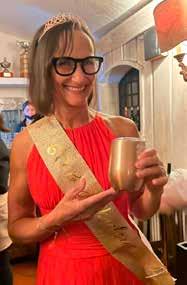



PORTILLO SKI TRIP 2022 THESNOWSOCIETY.COM SCENES









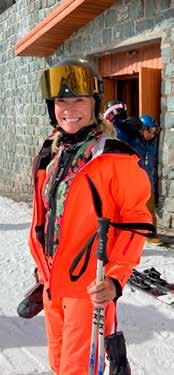
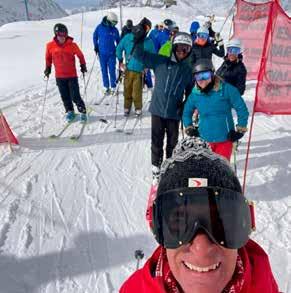
TricksoftheTrade
by JULIA MANCUSO
The moment I click into my skis, I know everything is going to be wonderful. I’m outside doing what I love more than anything, or damn near close. Not that I haven’t had my fair share of crashes, surprises, and disappointments—but one thing I’ve always been known for was managing to whisk up a smile no matter what.

When I was a little girl, I drew a poster of myself winning a gold medal. I didn’t know much about vision boards. Possibly they had yet to be invented. Honestly, I just thought I was being funny, victorious me drawn as it was on the backside of a Tommy Moe poster. I made sure my team kept it up on the wall as I trained and worked and sweated my way to the World Cup. Looking back, it was a bold statement, but it always brought me back to my favorite quote, one attributed to Henry Ford: “Believe you can or believe you can’t, either way you will be right.”
For me, it’s all about positivity. To achieve success on the mountain or in life, it’s vital to approach it from a place of joy. In times of stress, I think of things that make me happy, helping keep my mind and body clear to focus on the moment.
Our bodies are incredible contraptions, capable of astonishing things, but they tense easily when stressed. When I first made it to the World Cup, I felt so nervous to perform. Errors slipped into my runs at the first turns and my focus oriented towards not making mistakes rather than the true goal—skiing fast. Eventually one of my coaches pulled me aside. “You look like you’re trying too hard. You’re overthinking. Right before you kick out of the gate, think of jelly doughnuts and surfing. Forget about the results. Just ski.” The impact this had on me was remarkable. Then and there I made a pact—soon a tradition—of smiling and laughing while I kicked out of the start gates, from Killington to St Moritz and back.
Next time you’re standing on top of a run that’s a little intimidating, or maybe you’re skiing for the first time after an injury, try my trick. Close your eyes, visualize yourself making awesome turns, and think of something that fills your body with that warm fuzzy feeling of joy and pumps out all those endorphins that skiing produces so magically. And don’t forget to smile before dropping in.
130
LAST RUN









 GOLDBERGH.COM
welcome to the world of goldbergh
Welcome to the world of GOLDBERGH
GOLDBERGH.COM
welcome to the world of goldbergh
Welcome to the world of GOLDBERGH











































































































































 ANDREW
ANDREW
 Writer
Writer



 MATTIAS FREDRIKSSON Photographer
MATTIAS FREDRIKSSON Photographer




























































































































 by MICHAEL MASTARCIYAN
by MICHAEL MASTARCIYAN


















 YANA Onesie JET SET Boots INUIKII HAT MAESTRA NATI DAVID Traje de Luces CARMEN MOTA
YANA Onesie JET SET Boots INUIKII HAT MAESTRA NATI DAVID Traje de Luces CARMEN MOTA
 LUCIA
DAVID
Traje de Luces CARMEN MOTA
LUCIA
DAVID
Traje de Luces CARMEN MOTA





 LUCIA Scarf NOBIS Pants BOGNER Sweater FRAUENSCHUH Boots INUIKII
LUCIA Scarf NOBIS Pants BOGNER Sweater FRAUENSCHUH Boots INUIKII


 PHOTO BY JACE ROMICK PHOTOGRAPHY
PHOTO BY JACE ROMICK PHOTOGRAPHY















 by MICHAEL MASTARCIYAN
by MICHAEL MASTARCIYAN














 by ANDREW FINDLAY | photography by KARI MEDIG
by ANDREW FINDLAY | photography by KARI MEDIG
 Ski guide Guido Schilling skis the slopes of Volcán MochoChoshuenco in Chile's Lakes and Volcanoes District.
Ski guide Guido Schilling skis the slopes of Volcán MochoChoshuenco in Chile's Lakes and Volcanoes District.









































